
MARTHA’S VINEYARD / EARLY SUMMER 2023 MARTHA’S VINEYARD / EARLY SUMMER 2023 SIMPLE / SMART / SUSTAINABLE / STORIES SIMPLE / SMART / SUSTAINABLE / STORIES CRUISING with Island Eats MV WHAT'S SO BAD ABOUT ZOOS? Summer Garden Food · Stoves! · Local Hero: Brendan O'Neill · Dear Dot Answers Your Questions TM JENNY DEVIVO RESCUES FOOD and Fills Tummies @bluedotlivingmv A Giant Seahorse at a Whale House Stina Sayre's Slow Fashion Gannon & Benjamin's 100th Boat MADE ON MV
We have four clients: you, your neighborhood, the island, the planet
ARCHITECTURE. ENGINEERING. BUILDING. INTERIORS. SOLAR. SOUTHMOUNTAIN.COM


BDL 1 marthasvineyard. .com
ENJOY MORE TIME OUTSIDE!
“Look again at that dot. That’s here. That’s home. On it everyone you love .” –Carl Sagan
President Victoria Riskin
CEO Raymond Pearce
Editor Jamie Kageleiry, editor@bluedotliving.com
Senior Writer Leslie Garrett
Associate Editor Lucas Thors
Copyeditor Laura Roosevelt
Creative Director Tara Kenny
Design/Production Whitney Multari
Digital Projects Manager Kelsey Perrett
Social Media/Digital Projects Julia Cooper
Contributing Editors Mollie Doyle, Catherine Walthers
Ad Sales Josh Katz, adsales@bluedotliiving.com
Contributors, this issue Randi Baird, Julia Cooper, Mollie Doyle, Jeremy Driesen, Sheny Leon, Sam Moore, Harry Ricciardi, Laura Roosevelt, Catherine Walthers
Bluedot and Bluedot Living logos and wordmarks are trademarks of Bluedot, Inc.
DEER, TICK & MOSQUITO CONTROL!
(508)627-2928 | MV@oh-DEER.com
oh-DEER.com/locations/MV

• SAFE FOR YOU, YOUR FAMILY & PETS!
• KILLS TICKS & MOSQUITOS ON CONTACT.
• AN EFFECTIVE ‘GREEN’ ALTERNATIVE TO PESTICIDES & CHEMICALS
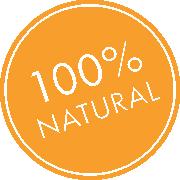
ohDEER offers you and your family a proven and safe solution to control ticks and mosquitoes so that you can enjoy your yard. Our products are true all-natural repellents that contain no pesticides or chemicals of any kind.

Copyright © 2023. All rights reserved.
Bluedot Living: At Home on Earth is printed on recycled material, using soy-based ink, in the U.S.
Bluedot Living magazine is published quarterly and is available at newsstands, select retail locations, inns, hotels, and bookstores, free of charge. Please write us if you’d like to stock Bluedot Living at your business. Editor@bluedotliving.com
Sign up for the Martha’s Vineyard Bluedot Living newsletter here, along with any of our others: the BuyBetter Marketplace, our national ‘Hub” newsletter, and our soon-to-be-launched Bluedot Kitchen newsletter: marthasvineyard.bluedotliving.com/sign-up-for-ournewsletters/
Subscribe! Get Bluedot Living Martha’s Vineyard and our upcoming Bluedot GreenGuide mailed to your address. It’s $24.95 a year for all four issues plus our Green Guide, and as a bonus, we’ll email you a collection of Bluedot Kitchen recipes. Subscribe at bit.ly/MVBluedotSubs
Read stories from this magazine and more at marthasvineyard.bluedotliving.com
Find Bluedot Living on Twitter, Instagram, Facebook, and YouTube @bluedotliving

2 MARTHA’S VINEYARD /EARLY SUMMER 2023
BDL • OUR TEAM
• • • • • •
Hi there, readers,
Time sure does fly. In two years, we’ve run hundreds of stories in our Martha’s Vineyard magazines and on our websites — stories about Islanders like Liz Durkee, Noli Taylor, Ollie Becker, and Farley Pedler, who are working hard to make better farms, better ponds, better homes, and better climate protection. We never seem to run out of inspiring people and their interesting work to celebrate in these pages.
We’re grateful to all the people who’ve taken time to talk with us, ride around in their cars with us, advertise with us, and send us leads for stories.
(Thank you!)
I asked my boss, Bluedot founder Victoria Riskin, to sum up our two years: “I remember that first issue, and our story on the Plastic-Free MV kids — their actions are what inspired me to start Bluedot Living in the first place. They inspire me still! We knew when we launched the magazine that people were probably

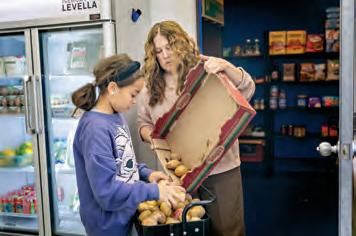
tired of hearing only about the problems associated with climate change. And we knew, just from living on the Island, that plenty of people like the kids were working on solutions, and doing incredible things in our community. I am so happy that we’ve found so much of that here.”
In this issue, we focused on people who make things here on Martha’s Vineyard, from slow fashion (Stina Sayre) to giant seahorses (Tony Holande) to solar sailboats (the crew at Gannon and Benjamin). And we celebrate the problem-solvers: Jessica Mason, who’s remaking the takeout experience; Jenny DeVivo, who rescues food; and Brendan O’Neill, who’s been conserving our public spaces for close to forty years now.


Time does fly.
Enjoy, and happy summer.
Oh, and some fun news: Our beloved advice columnist, Dot, now has her own daily newsletter, in which she dispenses daily Climate Quick Tips and answers your most pressing questions. Sign up here: bit.ly/BDL-newsletters.
–Jamie Kageleiry
3 marthasvineyard. .com EDITOR'S LETTER
CONTENTS
Upfront
3 Editor's Letter
6 Made Local: MV Sea Salt’s Cool Containers
7 Put These Events on Your Calendar: Birds, Art, Fashion Films, and More Art
10 In a Word: Shivelight
Features
21 What’s So Bad About Zoos? Profit and spectacle with conservation on the side?
By Sam Moore
In some ways, zoos are better for studying Homo sapiens than wild animals: Zoos reflect and refract our desires for connection with nature, with animal intelligence, and with pre-history. How they move forward depends in part on these desires.
26 Stina Sayre: At the Cutting Edge of Sustainable Fashion
 By Julia Cooper
By Julia Cooper
Stina Sayre has always centered her design philosophy around valuing people, materials, and the planet. Call it slow fashion — and it’s made right here on Main Street, Vineyard Haven.
34 Waste Not, Want Not: Jenny DeVivo Rescues Food
By Catherine Walthers
Sometimes Cronig’s gets food it didn’t order, or has produce with funny spots on it, or has food that’s just past its “sell by” dates. Enter Jenny DeVivo, who arrives three days a week to “rescue” the food and stock the larders at the Boys and Girls Club.
50 One Hundred Boats
By Harry Ricciardi
Gannon and Benjamin’s new solar-powered sailboat is the boat yard’s one hundredth over more than forty years of making wooden boats on the Vineyard Haven harbor.
Departments
11 Handmade: A Seven-Foot-Tall Seahorse Next to a Whale House.
By Mollie Doyle
15 Dear Dot
Could You Help Me Find Eco-Friendly Cleaning and Beauty Products?

26 Garden to Table: Summer Veggies
By Laura D. Roosevelt Plant now to eat all winter.
36 Room for Change: Your Stove
Mollie Doyle gets inducted into the realm of induction cooking.
46 Cruising: With Island Eats’
Jessica Mason
By Lucas Thors
Jessica Mason zooms around the Island in her electric Volvo, revolutionizing the whole takeout business as she goes.
61 In a Word: Biomimicry
64 Local Hero: Brendan O’Neill
For almost forty years, he’s helped Vineyard Conservation Society fight for all our natural spaces.
Find Us! Sign up for our biweekly Martha's Vineyard Bluedot newsletter: bit.ly/MV-NEWSLETTER At marthasvineyard.bluedotliving.com and Bluedotliving.com How to Get Rid of (Almost) Anything The Bluedot Buy Better Marketplace Lots More ‘Dear Dots’ More online
PHOTO THIS PAGE: RANDI BAIRD
Cover photo: Stina Sayre, by Randi Baird
“Eating at the cafeteria and using these plastic utensils, it’s very obvious there is a lot of waste with forks, knives, and spoons being individually wrapped. This is the mindset of throwaway culture which I addressed in my research.”
–Juliet Falk, Bronx High School of Science, Bronx, New York
“I am writing a children’s book about sustainability and the environment, and planting more native tree species in the Ojai area to reintroduce them into the ecosystem.” –Arinze Okigbo, Thacher School, Ojai, California
“Corporations killing peace. Landfills, junkyards, tar, and grease. Dark clouds don’t mean just rain anymore.” –Lyrics from Sadie Rooney, Andover High School, Andover, Mass.
“A seagull with its head trapped in a ceramic jar. She could see its panic, and watched frozen as the tide approached. Then, as suddenly as an elastic band’s snap, she bolted towards it.” –Stanza from Izzy Morgan, Elmwood School, Ottawa, Ontario
Do you know a student or a school working to create a more sustainable future? We’d like to meet them!


Please contact program director Lucas Thors: Lucas@Bluedotliving.com
Meanwhile, check out the Bluedot Institute: bluedot-institute.org
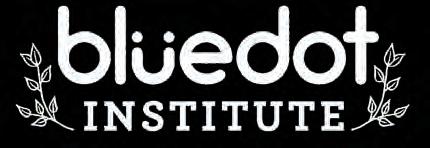
BDL 5 marthasvineyard. .com
The Bluedot Institute gathers the voices of students from around the country working on climate change projects. Here are a few.
MV SEA SALT Favorite Things Salt Your Cocktails
We’ve always loved Martha’s Vineyard Sea Salts; we give the tiny “traveler packs” as hostess gifts, and the tall sea glass cylinders for holidays.
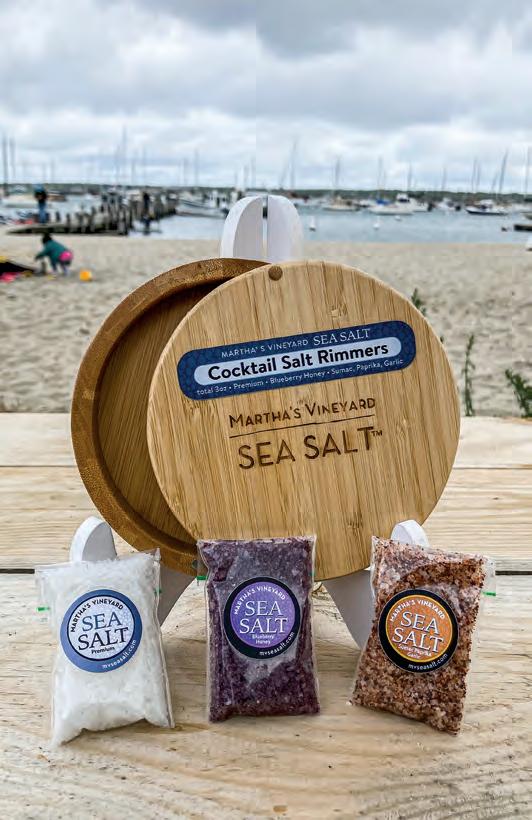
MV Sea Salt has always held sustainability at the center of their practice. Heidi and Curtis Feldman and their crew use open Atlantic Ocean water, filtered at 50 microns to remove sand, organic material, and other contaminants before setting the water out in large, covered “ponds” — basically large containers that allow the water to evaporate. When the water has fully evaporated, the result is a beautifully pure sea salt that’s ready for packaging.
Although there is no USDA “organic” designation for minerals, MV Sea Salt does their best to make a product that is as close to the Earth as possible. Their product is designated as a “raw” salt, meaning it is not artificially dried by being boiled or heated to more than 115 degrees. Instead, the company relies on a


solar drying process. It takes a bit longer, but the results are worth the wait (and better for the planet).


MV Sea Salt recently made a major design change to their bamboo sea salt cocktail rimmers (which themselves can be repurposed when you’ve used them up at your margarita party). Each container includes one ounce of three different salts (premium original; blueberry and honey; and sumac, paprika, and garlic), and each package is resealable and reusable. It’s an ecofriendly party treat that’s easy to take to the beach, on the boat, or to a picnic in the park.
Happy,

FAVORITE THINGS/EVENTS • UPFRONT 6 MARTHA’S VINEYARD /EARLY SUMMER 2023
MV Sea Salts at the West Tisbury Farmers Market, or at marthasvineyardseasalt.com –Bluedot Living
salty summer! Find
SUSTAINABLY with
Offset energy costs and reduce the environmental impact of your home by switching to solar. Cape Cod 5 offers solar financing with flexible terms and competitive rates to qualifying homeowners. Member FDIC NMLS #401717 SCAN ME Reach out to us. We’re here to help. capecodfive.com | 888-225-4636 Visit our Vineyard Haven or Edgartown Banking Center or scan the QR to learn more.
We’ll help you build a brighter future.
Put These on Your Calendar
THE LOST BIRD PROJECT
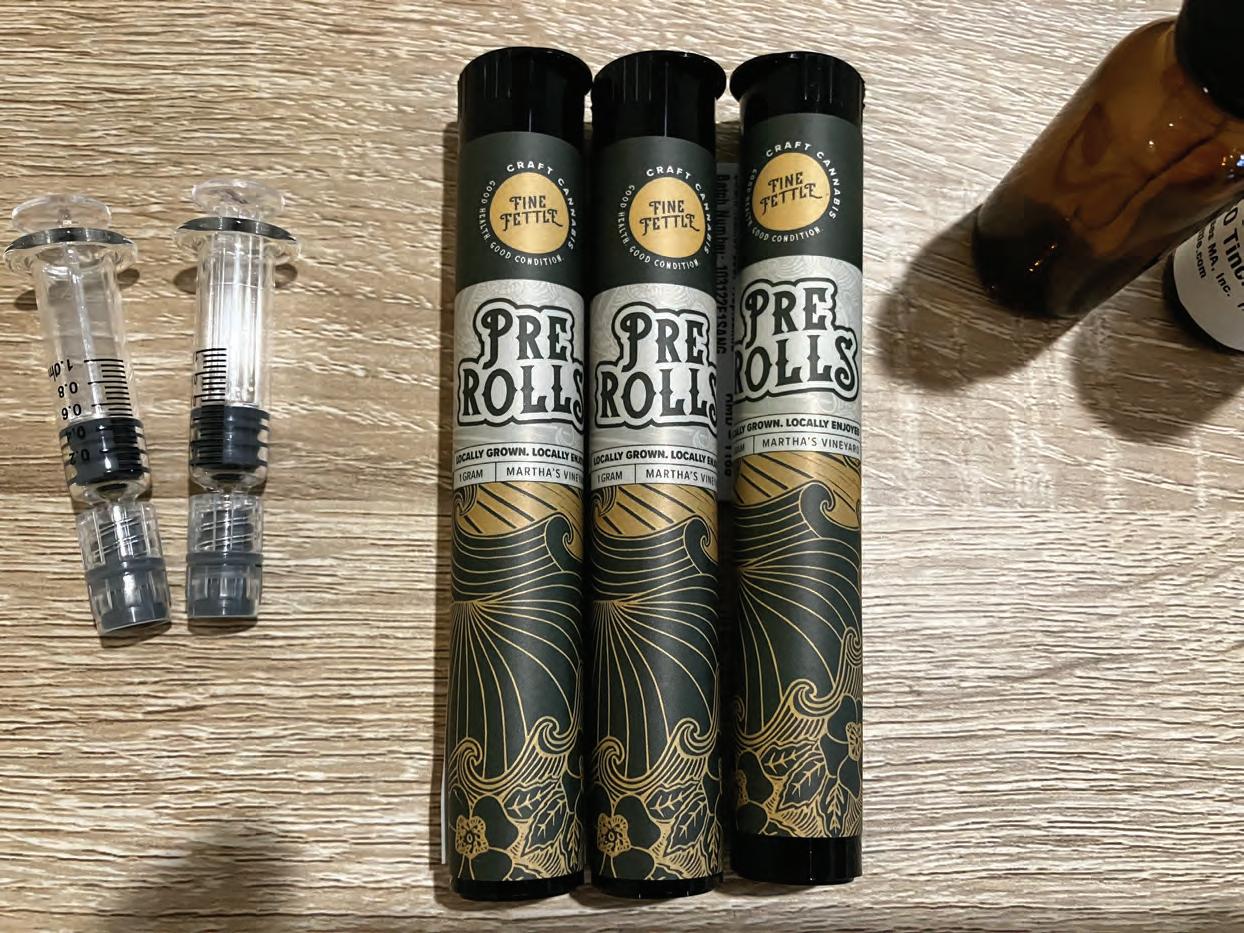
MV Museum · Until July 30

You’ve probably noticed by now that we at Bluedot cherish birds. This Martha’s Vineyard Museum has an intriguing exhibit up until July 30 (with some outside sculpture until next spring). For the Lost Bird Project, artist Todd McGrain created a memorial to birds that have been driven to extinction in modern times. “Part natural history, and part artist’s diary,” the Museum says, the exhibit “features larger-than-life sculptures of five vanished species of birds along with a companion exhibition diving deeper into Todd’s work to explore each bird’s story and the lessons learned from their extinctions.” Find more info at mvmuseum.org/exhibition/the-lost-birds-project
WOMEN LANDSCAPE ARTISTS

Field Gallery · Art Premiere, July 29
The Field Gallery has an excellent show opening Saturday, July 29 (4 to 6 pm) featuring women landscape artists Jennifer Brown (who works in textiles), Jennifer Christy, and Susie White. More info at fieldgallery.com

UPFRONT • FAVORITE THINGS/EVENTS LOCALLY GROWN. LOCALLY ENJOYED. breast-feeding may pose potential harms. It is against the law to drive or operate machinery when under the influence of this product. KEEP THIS PRODUCT AWAY FROM CHILDREN. There may be health risks associated with consumption of this ed by two hours or more. In case of accidental ingestion, contact poison control hotline 1-800-222-1222 or 9-1-1. This product may be illegal outside of MA. 510 State Rd, West Tisbury, MA 02575 • 508.687.0131 • finefettle.com WALK-INS WELCOME
Spring Shoreline by Jennifer Christy
Put These on Your Calendar
MORE ART! FARMS AND FOOD
MVBank, Chilmark · August 17, 5:30 pm


We’ll be co-hosting an exhibit “Farms and Food on Martha’s Vineyard,” with Martha’s Vineyard Bank, with art from the Martha’s Vineyard Hospital’s Permanent Art Collection, also known as the Edward Miller and Monina von Opel collection. The pieces will reflect a collection in our upcoming August issue, dedicated to the farms and hardworking local food producers of all sorts. Watch our newsletters for information.



FAVORITE THINGS/EVENTS • UPFRONT 8 MARTHA’S VINEYARD /EARLY SUMMER 2023 Serving the Community of Martha’s Vineyard 1(833) MV SOLAR (687-6527) Solar System Installation New & Retro t Battery Storage Canopies & Pergolas Commercial & Residential Reach 125,000 eco-conscious readers in our print magazine and email newsletters, for as little as $100 a week. Get in touch! adsales@bluedotliving.com Advertise with us! THE HUB / MARTHA’S VINEYARD SAN DIEGO / LOS ANGELES BUYBETTER MARTKETPLACE BROOKLYN / YOUR DAILY DOT
PHOTO BY SHENY LEON
Slipaway Farm.
FASHION REIMAGINED The Grange · August 25













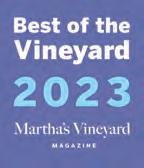


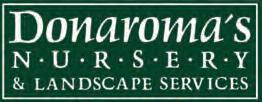
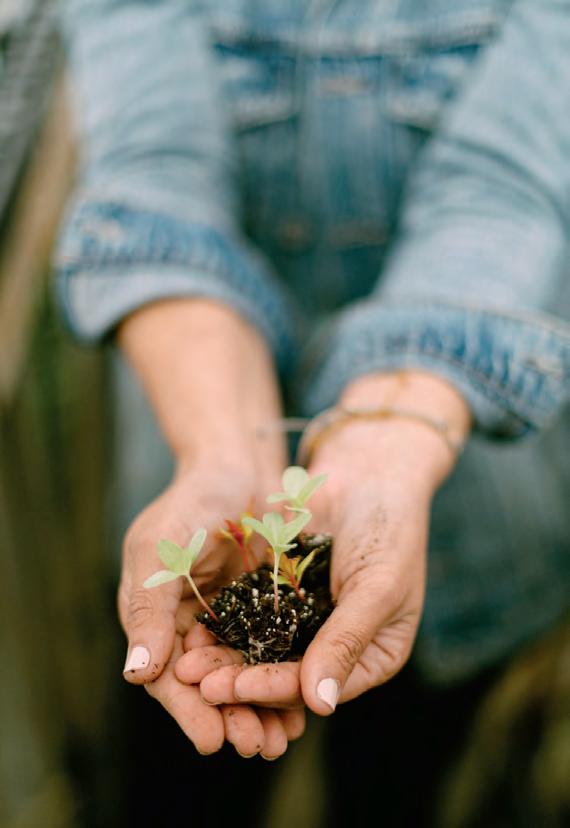
As you’ll read in Julia Cooper’s story in this issue about designer Stina Sayre, the fashion industry commits myriad ecological sins, day after day. What if fashion could be different? In this documentary, fashion designer Amy Powney is on a mission to create a sustainable collection from field to finished garment, and to transform the way we engage with fashion. Bluedot will sponsor a short conversation along with the film and stay for the wine, dessert, and fashion show after. Check out newsletter for details as we get closer to the date. (Sign up for that at marthasvineyard.bluedotliving.com), or watch the circuitarts.org website. See the trailer here: fashionreimaginedfilm.com



UPFRONT • FAVORITE THINGS/EVENTS 9 marthasvineyard. .com Interested in making your yard a haven for wildlife? We'll visit your yard and give you site specific recommendations to create shelter, water, and food for pollinators, birds, and other wildlife. A site visit is free, and recommendations are designed to fit your needs and resources. Join the Natural Neighbors Network To sign up, contact Rich Couse rcouse@biodiversityworksmv.org (508) 338-2939 office
Perhaps it’s been raining, and the forest smells fresh and scrubbed clean. The sun is now high in the sky, and as you venture deeper into the trees and the foliage above you thickens, you notice that the sun’s shafts slip through the canopy like glittering swords. You can picture it, can’t you? It feels holy. It’s … what would we call it, exactly? It’s “shivelight,” some stranger on Twitter posits and
Google confirms — a word conceived by poet Gerard Manley Hopkins in 1888 to describe those lances of light that pierce a tree’s canopy or foliage. Another poet, Dylan Thomas, referred to this phenomenon as “windfall light.” Writer C.S. Lewis coined the term “Godlight,” writing: “Any patch of sunlight in a wood will show you something about the sun which you could never get from reading books on astronomy. These pure and spontaneous pleasures are ‘patches of Godlight’ in the woods of our experience.”

The Japanese call it Komorebi, a word that sounds like poetry too.



I’m with Lewis. Nature delivers information to us that we won’t find in science books, and poets help us put words to what we’re seeing. So let’s give Hopkins the final words, from his poem:
–Leslie Garrett

IN A WORD 10 MARTHA’S VINEYARD /EARLY SUMMER 2023
Shivelight 'shīv 'līt in a word Your Renewable Energy Solution Solar, plus smart, safe and long-lasting battery technology. Power your home with clean energy around the clock with solar and batteries. www.fullers.energy 508.696.3006 info@fullersenergy.com Support Bluedot! We love bringing you stories about Islanders addressing climate change. Generous contributions from readers such as you helps us do this. Make a one-time, monthly, or annual contribution here. And we’ll email you a downloadable collection of Bluedot Kitchen Recipes Down roughcast, down dazzling whitewash, wherever an elm arches, Shivelights and shadowtackle ín long lashes lace, lance, and pair.
MADE ON MV
for a A Seahorse Whale House
A copper seahorse welds together the land and sea.

Kale and puppies are the reasons I learned about Tony Holand’s seahorse. My husband, Thomas, had swung into Cronig’s to pick up some kale for a minestrone soup and ran into Tony in the vegetable aisle. Tony’s news of the day: five new puppies. He showed Thomas pictures. Thomas texted the pictures to me. We had to go look. Not 24 hours later, we were on the floor of Tony’s and his wife Dawn Bellante’s
cozy Vineyard Haven living room with puppies, and three adult dogs, swirling around us.
But before we made it to their living room floor, I had spied the head of a giant copper seahorse through the window of Tony’s shop.
“Is that giant seahorse going on a roof?” I asked.
Tony is one of the country’s most renowned weathervane makers, crafting
custom weathervanes for the likes of Steven Spielberg.
“No. It’s going in someone’s yard,” Tony laughed.
Since we already have a 13-year-old dog at home, we had to let the puppy fantasy go. But I could not stop thinking about the seahorse. There was a sevenfoot high by eleven-foot long sculpture in Tony’s shop, and I had to know its story — the who, what, and why of it. I
HANDMADE • A SEAHORSE 11 marthasvineyard. .com
Story by Mollie Doyle Photos by Jeremy Driesen
Holand begins with a sketch, then lays out the pieces he'll weld into a sculpture.
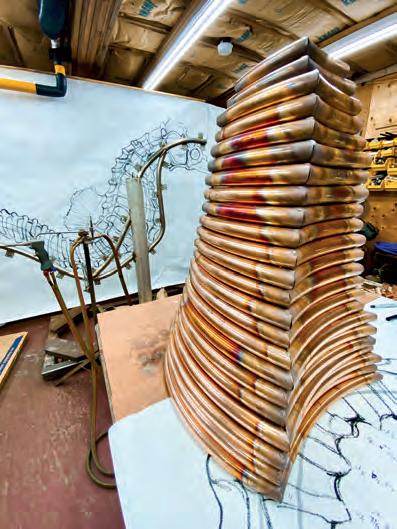


A SEAHORSE • HANDMADE
12 MARTHA’S VINEYARD /EARLY SUMMER 2023
called Tony and asked if I could come take a closer look and hear the story. He was delighted to talk about it.
The story goes that one of Tony’s weathervane clients had asked him to make a thirty-two-inch whale for an Aquinnah property. Tony went to look. They talked it over. “I was not feeling a whale,” Tony says. “I just couldn’t see how it would flow or relate well to the house or the spectacular view of the Sound.”


The client’s house was inspired by Steven Holl’s “Whale House,” an award-winning Edgartown house that, unfortunately, has been demolished. Both houses used the physical architecture of a whale as a way to inform their shape and structure. Nevertheless, the client agreed with Tony’s assessment that a whale on the lawn wasn’t quite right. They walked around the property some more, batting ideas around. As Tony tells it, “We walked to a slightly elevated place next to the house and he [the client] stretched his arms out wide and said how about here? But something really big?”
They decided to think on it and keep talking. Tony knew the client and his family were avid equestrians. What about bringing the idea of the ocean and horses together with … a seahorse? Tony drew it up and photoshopped a larger-than-life
seahorse in a space near the house. Too small. They scaled it up a bit more. As a model, it worked. The client was game. Next was the job of making it, which Tony knew would take the better part of a year. Tony had several other projects on his plate — he has a waitlist of more than two years for custom projects. “I needed to clear my calendar, but I also needed physical space” he says. “This was going to take over the studio.” The client was patient. And Tony had some research to do. “I had to learn about seahorse anatomy. I also wanted the ribs of the seahorse to
echo the architecture of the house, which has rib-like lines.” He laughs: “And I like to slightly overbuild everything. Then I can sleep well at night.”
The seahorse was not Tony’s first big project. He has built large Chinese and Bhutanese dragons, along with the largest full-bodied weathervane in the world: the Nittany Lion at Penn State’s Beaver Stadium. But the thrill and gift of being paid to do work he loves is still fresh. Tony brushes a hand over his shaved head and says, “It is pretty rarified air to be here. A metal sculptor on Martha’s Vineyard.

HANDMADE • A SEAHORSE 13 marthasvineyard. .com
That people come to me with ideas and trust me to realize them. Trust is the whole show. It’s pretty amazing.” Tony has earned this trust. This year will be his twenty-fifth year as a metal craftsman and his twentieth year on his own. His mentor and partner, Travis Tuck, died in 2002.

Tony grew up in Pasco, Washington, where his family has a 7,000 acre wheat and barley farm. “I was driving combines and tractors from [age] twelve to [age] twenty.” But Tony was always interested in drawing and art. One spring at North Idaho College in Coeur d’Alene, where

he was studying commercial art and business, “a friend who had returned from a summer on the Vineyard spoke of this magical place and asked if I would like to go. I said, ‘I’m in … Where the hell is Martha’s Vineyard?’”

They got jobs at a bike shop. Tony had fun, but he never thought he’d stay. After finishing school, he saw an ad for an apprenticeship with Travis Tuck. “It appealed to me. The drafting, the sculpting. To be given an idea and then to realize it,” Tony says. These days, he hires Ty Rossi and Greg Blaine to weld and build the stainless-steel frames for his sculptures and weather vanes. While they built the seahorse frame, Tony finished other projects and made space. And then, in the spring of 2021, he set to work. The seahorse has about 250 copper panels and 300-plus pieces of copper tubing — each a different size and shape. “I wanted it to feel completely organic,” he says. Indeed, even though it’s made of metal, its shape undulates. The seahorse skeleton
Continued on page 57

14 MARTHA’S VINEYARD /EARLY SUMMER 2023 A SEAHORSE • HANDMADE Native plant specialists and environmentally focused organic garden practices. Design • Installation • Maintenance (508) 645-9306 www.vineyardgardenangels.com Garden Angels Bring beauty to your property
Dear Dot,
I would love to find great, gentle, and good-smelling cleaning and beauty products that are also high-concentration and low-volume, but I’m totally overwhelmed by the vast amount of marketing from many different companies telling me why their product is so great and so much better than everyone else’s. Do you have any fave cleaning products or bar shampoo recommendations?
dot DEAR
to find the money to hire someone to clean our apartment, one less chore for us stressed out parents. As I navigated new motherhood, Max (our cleaning gentleman) imposed order on literal chaos, cleanliness on filth, and assured me, as only a childless 24-yearold young man could, that I was mothering just swell.
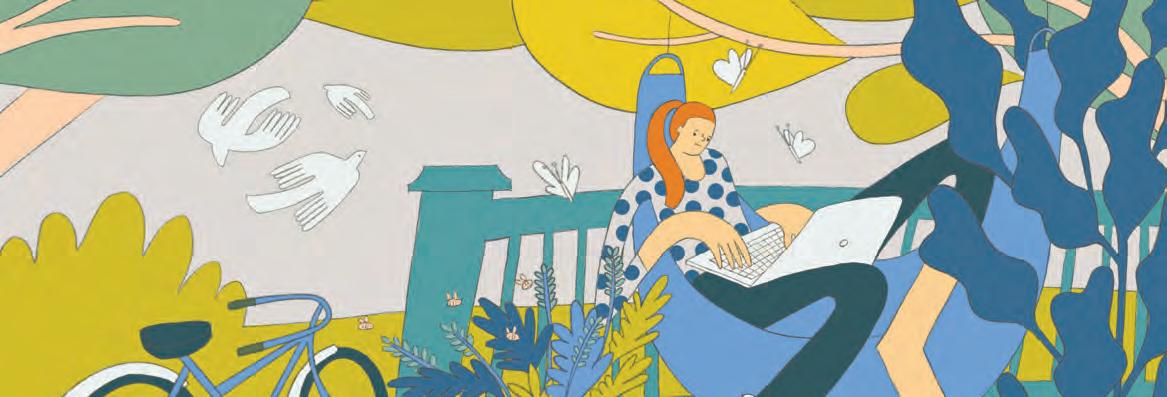 – Jennifer
– Jennifer
The Short Answer: You can assemble a DIY cleaning kit using good old white vinegar, lemons, baking soda, and a bit of castile soap. Since you love scents, add in your favorite essential oils (lavender is a popular one, or anything citrus-y). You’ll not only have all you need to get your home sparkling but you’ll save yourself a small fortune, too. The internet is chock-a-block with do-it-yourself cleaning recipes so get Googling and pick your favorite.
(Dot’s favorite? A surface scrub of baking soda and enough water to create a paste. Add a few drops of dish soap. You can make what you need or store extra. If it hardens, just add a bit more water to turn it back into a paste.)
My dear Jennifer,
Many, many years ago, I left my job as a magazine editor to become a freelance writer, and my days were filled with writing books and magazine stories. It was a glorious time. And then Mr. Dot and I decided to have a baby. I birthed this baby on a Friday morning with the sky a perfect blue outside the hospital window. She was magnificent, this baby Dot. The next day, we took her home, where, having little to no experience with babies, I imagined she would doze in a basket while I finished my regular magazine column that was due on Monday.
It might surprise no one to discover that my column was submitted late and no doubt required extensive editing. This baby, this perfect creature that I expected would snooze often, coo occasionally, and charm us all, instead wailed and screamed and was single-handedly responsible for a path worn into the hall carpet as I paced with her day and night like some sort of postpartum Lady Macbeth.
Babies, as it turned out, were a lot of work, this baby in particular. And so, Mr. Dot and I scrounged in our sofa cushions
Max moved on, and we hired Lindsey, a lovely woman with three young children and a commitment to Earth-friendly products born of her concern about the indoor air pollution from cleaning products, which Dot shares.
Turns out, Lindsey uses, as she puts it, “a lot of white vinegar.” She even put a glass bowl of water and white vinegar in my (disgusting) microwave, turned it on for five minutes, waited a few minutes longer, then wiped it clean. I pointed out that Lindsey’s favorite cleaning product wasn’t making me hungry for fries, so what gives? To mitigate the vinegar smell, she said, she adds a few drops of essential oils (though vinegar’s smell dissipates as soon as it dries, she assured me). BTW, Jennifer, have you seen the Instagram lady’s microwave lemon trick? It’s similar to Lindsey’s vinegar approach, but with an actual lemon instead!
And that’s the thing with cleaning products — you can assemble a DIY kit of good old white vinegar, lemons, baking soda, and a bit of castile soap. Since you love scents, add in your favorite essential oils (lavender is a popular one, or anything citrus-y). You’ll not only have all you need to get your home sparkling, but you’ll save yourself a small fortune, too. The internet is chock-a-block with do-it-yourself cleaning recipes so get Googling and pick your favorite.
(Dot’s favorite? A surface scrub of baking soda and enough water to create a paste. Add a few drops of dish soap. You can make what you need or store extra. If it hardens, just add a bit more water to turn it back into a paste.)
As for castile soap, I am slavishly devoted to Dr. Bronner’s for, well, pretty much everything, including washing my floors, my walls, my countertops, and my body. But not just any Dr. Bronner’s — the almond-scented version. (You’ll discover your own favorite — the Citrus Orange is a close second for me. The peppermint’s not bad, either.)
My friend Sarah, a home organizer (who often cleans for her clients) swears by Natura products. They’re available only to Canadian readers but if you can get your hands on them, Sarah
15 marthasvineyard. .com
Illustration Elissa Turnbull
insists you’ll love them. “My most favorite,” she raves, “is the cleaner with Australian tea tree oil. Most of my clients end up buying it.”
For personal care products, Bluedot’s Marketplace editor, Elizabeth, swears by Ethique. “Legitimately a great brand,” she says. The company is woman-founded and offers cruelty-free bar soaps, shampoos, and conditioners that really work, according to Elizabeth, who has Rapunzel-like tresses: “Works really well, a variety of scents, none overwhelming.” Elizabeth also notes that Ethique offers small sample sizes, which ship in paper containers in tiny boxes. “The whole brand is plastic free and is one of my favorite brands in our whole marketplace,” she says.
Catherine Walthers, Bluedot’s creator of all things sustainably delicious, just discovered a “heavenly” Moroccan Rose-scented deodorant in a cardboard container from Humble — she picked it up at a zero waste store. Cathy says that, like Bluedot’s Marketplace, the owners or managers of these stores are great sources for product info. “They usually test and know all the products,” she says.
Bluedot’s copyeditor, Laura Roosevelt, who's also been guiding us all through growing a garden that will feed us through the year and whose mother just might be the OG environmentalist, is, like you, Jennifer, converting to eco-friendly cleaning and personal care products. “One I love is Blue Heron Botanicals' Organic Lip Therapy products,” Laura says. “Their chapstick comes in a range of scents, packaged in heavy paper.” The company boasts that one sea turtle is saved for every lip therapy
product sold, which I confess alarms me somewhat because that means every lip therapy product left on the metaphorical shelf is an unsaved baby sea turtle. So please, everyone, buy yourself a Blue Heron Botanicals’ Lip Therapy product so we can save all the baby sea turtles!
I’d love to also open this question up to Bluedot’s wonderful readers, who no doubt have their own favorites — perhaps wonderfully scented ones. Please send your suggestions or comments to deardot@bluedotliving.com.
In the meantime, though, Jennifer, try not to sweat it too much. Dot holds firm that anxiety about making a misstep is misplaced. Avoid the worst culprits — anything that warns of being an eye/skin irritant, requires ventilation for use, is packaged excessively, or has a skull and crossbones or that scary bony hand on its label. But don’t knock yourself out trying to find the “perfect” cleaner or beauty product. Bluedot’s motto is a wise one: Buy less. But when you buy, buy better.
Squeaky-cleanly, Dot
Want to see more Dear Dots?
Find lots here:
bit.ly/Dear-Dot-Hub
Check out our new Daily Dot newsletter and get a Climate Quick Tip each weekday, and an answer from Dot each Saturday. On Sunday, Dot rests. Sign up here: bit.ly/BDL-newsletters

Sheriff’s Meadow Foundation congratulates


DEAR DOT 16 MARTHA’S VINEYARD /EARLY SUMMER 2023
on his retirement from the Vineyard Conservation Society and thanks him for 38 years of dedicated service
environment and community of
Vineyard.
Brendan O’Neill
to the
Martha’s
From Brookside Farm, a conservation restriction (CR). Photo by Kristen Geagan.
sheriffsmeadow.org
Room for Change: Your Stovetop
 Story By Mollie Doyle Photos by Randi Baird
Story By Mollie Doyle Photos by Randi Baird
ROOM FOR CHANGE • YOUR STOVETOP 17 marthasvineyard. .com
My induction into the realm of induction cooking.
About seven years ago, my parents let go of their beloved 40-yearold restaurant gas range and invested in an induction stovetop.
My mother was thrilled with this new electric cooking experience. A big vat of water for pasta boiled in less than two minutes rather than the five to eight minutes it used to take on her gas stove. She loved how easy it was to clean the flat surface — no more lifting up heavy metal grates and moving the ringed drip pans into the sink for cleaning. And she loved the evenness, predictability, and speed of the heat. According to the Massachusetts Clean Energy Center, induction cooktops heat up 50 percent faster and are substantially more energy efficient than gas or traditional electric stoves. And of course, my mom loved not burning fossil
fuels to cook. (My mom’s induction stove is fueled by the solar panels from her roof. If you install an induction stove but do not have solar, there is a good chance you will still be using fossil fuel-based energy to power your electric range.)
For those who don’t know how induction stoves work (I didn’t), let’s start by saying that they are not your grandmother’s electric range. They are more powerful, more energy efficient, and safer. Basically, induction stoves harness magnetic energy. Each one has a heat-proof glass-ceramic surface that sits above a coil of copper wire with a low radio frequency alternating electric current passing through it. The resulting electromagnetic field induces (thus “induction”) an electrical current to the vessel sitting on the glass-ceramic surface.
Induction cooking is not new. It was first patented in 1900, the technology debuted to much fanfare at the World’s
Fair in 1933, and in the 1970s, Westinghouse Electric Corporation’s Research and Development Center introduced a more modern iteration of induction cooking machinery. It wasn’t until about twenty years ago, however, that induction stoves gained any notable popularity, and even then, they were quite expensive. Today, you can spend as little as $1,100 or as much as $10,000 or more on an induction range, but we’ll talk more about costs in a moment. As for safety, the surface is not hot to the touch! It will automatically turn off if there is no pot on the surface conducting the energy. Nor will the stove continue to run if there is nothing left in the pan. As Ken Crane of Crane’s Appliance told me, “The pan might get warm, but once there is nothing to excite in a pan, the magic is over. No danger of fire.”
Clearly, induction stoves have a lot going for them, and cities like New York have mandated that all new stove installations be electric or induction. Nonetheless, like many avid cooks, I wasn’t convinced that an electric stove would be right for me. I love my gas stove for its powerful heat and the ability to tweak the heat ever so slightly.. This said, I was willing to keep an open mind. If my mom (who’s an amazing cook) could be converted, then it was possible I could too.
I reached out to chef and cookbook author (and Bluedot Living contributing editor) Catherine Walthers to get her take. I knew she had been cooking for several years on an induction cooktop at a client’s house and that she was planning to make the leap to induction cooking at home when she and her husband, builder and HERS rater David Kelliher, finish building their new house. (HERS is short for Home Energy Rating System. A HERS rater is a qualified professional who evalu-
Induction cooking is not new. It was first patented in 1900, the technology debuted to much fanfare at the World’s Fair in 1933, and in the 1970s, Westinghouse Electric Corporation’s Research and Development Center introduced a more modern iteration of induction cooking machinery.

YOUR STOVETOP • ROOM FOR CHANGE 18 MARTHA’S VINEYARD /EARLY SUMMER 2023
ates a home’s energy efficiency and health.)
Like my mom, Cathy liked the efficiency of heat from her client’s induction cooktop and the rapid response it had when she turned it down. “With gas, it takes a moment,” she said. “On an induction stove, it’s instant. I also liked that I could find a place where there was a real simmer. With my gas stove, I’d turn it down and sometimes, it would go out three or four times before I got it right, which was a pain in the neck. People have this idea that to be a chef, you need to cook on gas, but that is just not true anymore.” She tells me that she can tweak the heat as well as she could on her gas range and, like my mom, she also appreciated the ease of cleanup: “I can wipe it down and it looks beautiful.” But the most compelling argument for Cathy is the health aspect of induction cooking. “I was unsure about the decision until my husband came home with his multi-functional air quality monitor and measured the air in our old home. I was cooking and the machine said we were in the red as far as being exposed to harmful gas emissions. I reflected on the hundreds of hours I had spent being exposed to harmful chemicals while working at my stove. That meter sealed the deal for me.”
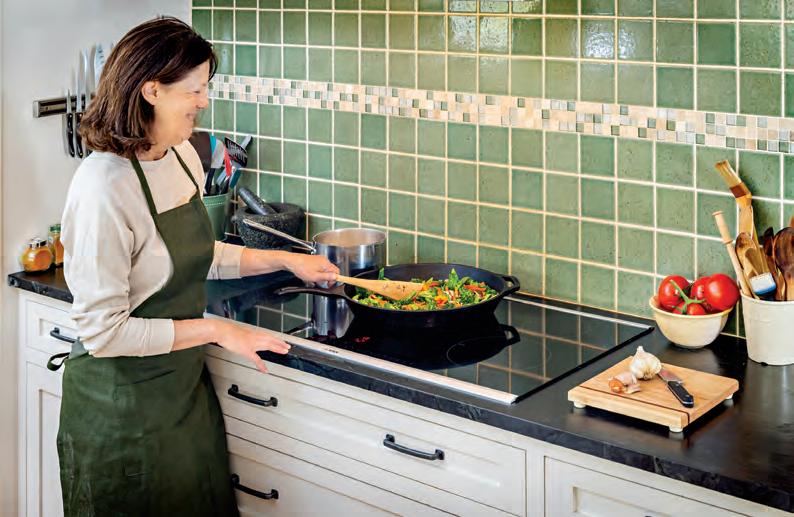
While of course I understood the general climate change implications of burning gas in my home, I had not thought about the emissions. Now I’ve learned that cooking with gas generates a number of invisible by-products. Scientific American reports that the biggest concern for human health is nitrogen dioxide (NO2). This gas is produced when natural gas is burned at high temperatures in the presence of nitrogen in the atmosphere, according to Josiah Kephart, an assistant professor in the department of environmental and occupational health at Drexel University. “We’ve known for a long time that [nitrogen dioxide] has many harmful effects on health,” he says. The EPA regulates outdoor nitrogen dioxide emissions, but does not regulate indoor exposure, even though their literature states that “breathing air with a high concentration of NO2 can irritate airways in the human
respiratory system.” And it turns out that gas stoves release harmful gases even when their burners are off: Stanford University found that even turned off, gas stoves release 2.6 million tons of methane into the air each year — an amount equal to the greenhouse gases released annually by a half a million cars.
Ranges, then a $3,500 Wolf cooktop — the same kind that Cathy has been using at her client’s home. We moved on to an LG slide-in induction range that sells for about $3,000, and finally, a $1,000 Fridgidaire cooktop. The higher end range and stove top cost is roughly comparable to a high end gas range or stove top, but the
I called Cathy again to further discuss the gas stove emission realities. She agreed that the numbers were a compelling argument for switching to electric. We also agreed that we didn’t fully understand the ins and outs of induction cooktops, the complications (if any) of repair, and any other pros and cons of induction stoves. So Cathy arranged for us to meet with Brendan Crane, a fourth-generation family member of Crane’s Appliance, who agreed to show us a range (sorry) of induction stove options and walk us through the mechanics.
We greeted Brendan and salesperson Brandon Brooks in the Vineyard Haven showroom. “We’re so excited by the sheer amount of induction options we can now offer our clients,” Brendan told us as he pointed from cooktop to range to cooktop. (A range includes an oven as well as a cooktop.) He showed us the high end ($5,000-$6,000) Bertazzoni and Verona
lower cost induction ranges and stove tops are more expensive than the lower end of gas ranges. To offset this, The Massachusetts Clean Energy Center (MassCEC) offers a $500 rebate for anyone investing in induction technology. To take advantage of this savings, visit masssave.com/en/getverified to get pre-qualified.
We asked Brendan what the most common service call was for an induction stove. He referred us to his uncle, Ken Crane, who runs the service department. To say that Ken Crane is a huge fan of induction cooking would be an understatement. He tells me, “I don’t think I would ever have a gas stove in my house again. The induction technology is just that good. I’d love to have a pro chef cook on gas and an induction cooktop side by side and compare the two. I guarantee you they’d choose induction.” Ken has an Electrolux stovetop in his home. “The biggest issue we see with induction
ROOM FOR CHANGE • YOUR STOVETOP 19 marthasvineyard. .com
Bluedot contributing editor Catherine Walthers cooks on an induction stove top, which she has come to love.
stoves,” he said, “is that the customers do not invest in good induction cookware.” Good induction cookware, he explained, is iron-based; a magnet will adhere to it so strongly that it’s hard to remove it. “There are a ton of companies selling cheap induction cookware,” he noted, “but because it is not good quality, the stove underperforms. For an induction stove to work at peak performance, the pot and stove need to have intimate contact. If you don’t have this, it is like running a microwave without food in it. It wears the technology out.”
He offered an example from his own experience: “I make three gallons of ice tea a week in two 4 quart induction pans. One pan, a Thermador, is an extremely high quality induction pot, and it makes the tea in half the time of the other. On the same setting! So I tell my customers: work with manufacturers, don’t trust that just because it says induction cookware on the box or on the website, that it’s good induc-
tion cookware. Buy the pots in person, maybe even with a magnet. If it’s a good induction pan, the magnet will jump to the pan like a long lost family member.”
Clearly, when thinking about upgrading to induction, you need to factor in the added expense of upgrading your pots and pans. Classic aluminum or aluminum clad, copper or copper clad, glass, ceramic and some stainless steel pots will not work, but a flat bottomed (no ridge!) cast iron pan will. So will pots made of carbon steel and enamel-coated metal pots like those made by Le Creuset (though Ken cautioned that enamel coated metal pots are not as good as the super steel, high quality induction pots).
Asked whether repairing induction stoves is complicated, Ken replied, “There’s a tremendous amount of technology below the glass surface. The stove is as reliable as the company that makes it. It’s way more reliable than it used to be.” And sure, the glass surface can break, but Ken noted that most stove glass breaks are
Tips for buying an induction stove

• As with buying any appliance, do the research. Read Consumer Reports, talk to appliance salespeople and service people, and consult your friends with new stoves.
• Have a budget that includes GOOD pots.
caused by items falling out of the cabinets above the stove. “These breaks can be avoided by just changing what you store in that space,” he said. I love it when good old fashioned common sense can prevail and prevent expense!
Ken offered one final selling point for induction stoves: “In the old days, everyone had gas stoves so they could cook even when the electricity went out. Now, that rationale doesn’t work. The ability to manually light a gas stove has been engineered out of the design.”
When I checked in with electrician Wagner Pereira about retrofitting a gas kitchen with an electric stove or new induction installation, he told me, “I love induction technology. Retrofitting for an induction stove or range is easy. And it’s the future.”
While I don’t think our family (or any family) should immediately jump on induction when we still have a good working stove in our house, I do think that when our stove dies, induction is our future.
• Know your kitchen’s spatial restrictions.
• Line up your electrician to help you install it.
• Line up a responsible way to dispose of your existing appliance.
• And then, get cooking!

YOUR STOVETOP • ROOM FOR CHANGE 20 MARTHA’S VINEYARD /EARLY SUMMER 2023
Profit and spectacle with conservation on the side?
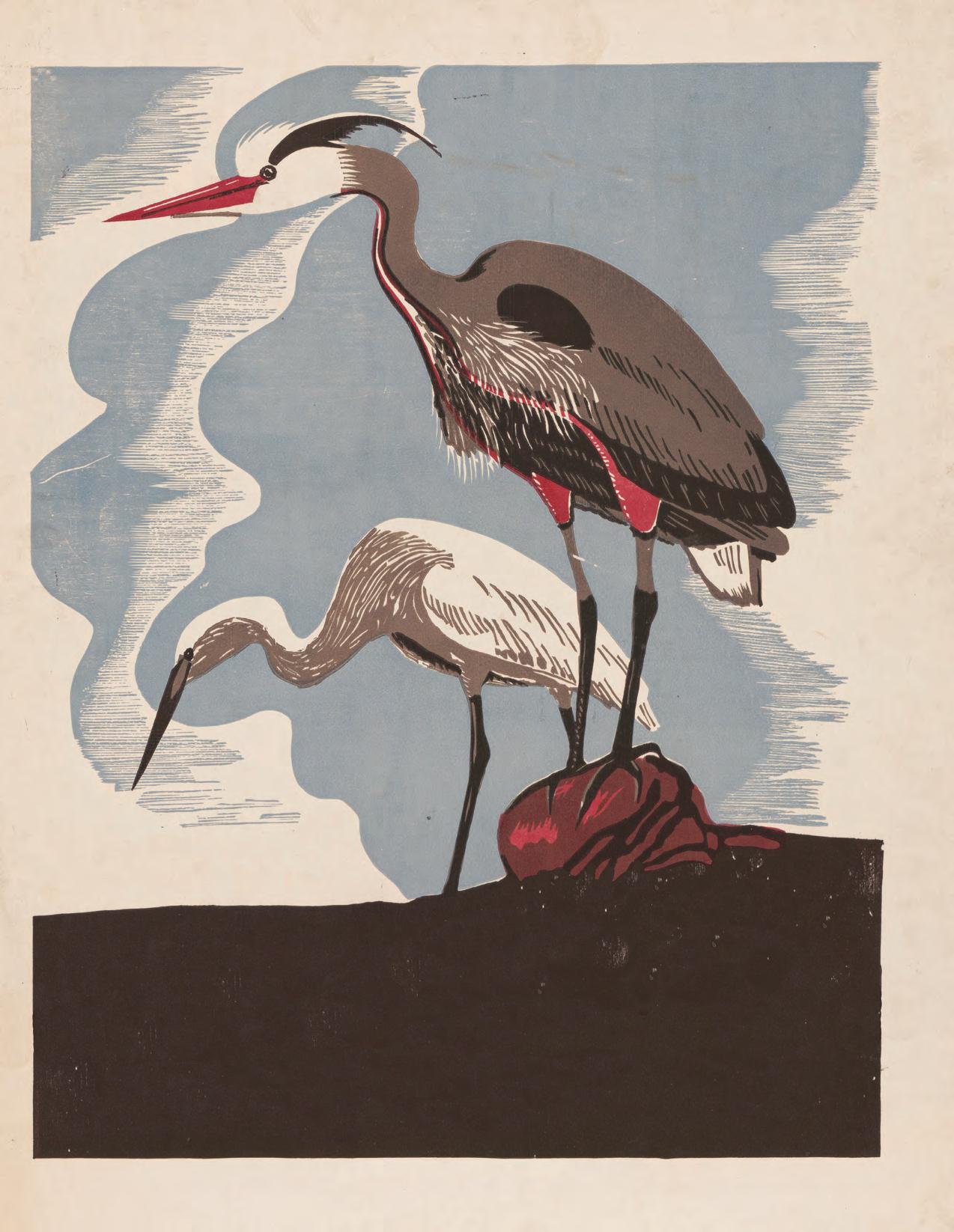
WHAT’S SO BAD ABOUT
ZOOS? ZOOS?
Story by Sam Moore WPA poster courtesy The Library of Congress
In 1902, two of the last female passenger pigeons in the world escaped from their pen in Woods Hole and vanished. Their captor had been Charles O. Whitman, an influential zoologist and the founding director of the Marine Biological Laboratory, who shipped a flock of research birds to New England every summer from his professorial perch at the University of Chicago.
With two pigeons lost in the woods of Cape Cod, and another packed off to the Cincinnati Zoo, Whitman was left with thirteen birds, a baker’s dozen plucked out of the billions that once darkened the skies of North America. As the remaining pairs laid nonviable eggs, hatched weakly-developed young, and died of tuberculosis, the professor’s flock dwindled. By 1907 all that remained were two hybrid males, infertile, their lineage crossed with that of turtle-doves.
Luckily, there were a few passenger pigeons left in Cincinnati, including an elderly pair named George and Martha Washington. Martha was the product of captive breeding, having hatched at the zoo in 1885, and the zookeepers worked hard to carry on her lineage, even taking her eggs to be incubated by other species.
But the effort was too late — there had been no coordinated program to maintain passenger pigeons in captivity while the species was still abundant. Martha, eventually the last of her kind, perished.
To be fair, the Cincinnati Zoo had other priorities. With hundreds of animals and only $96 in cash on hand, it had gone into receivership in 1898, and it rode a financial rollercoaster for decades. Its purpose was to attract people, not to save species, and to that end the zoo’s leadership employed a range of inventive, if not always successful, strategies. At various

22 MARTHA’S VINEYARD /EARLY SUMMER 2023
With two pigeons lost in the woods of Cape Cod, and another packed off to the Cincinnati Zoo, Whitman was left with thirteen birds, a baker’s dozen plucked out of the billions that once darkened the skies of North America.
ALL IMAGES COURTESY LIBRARY OF CONGRESS.
points in its early days, the zoo kept and sold domestic dogs, including a Newfoundland, a St. Bernard and a few Great Danes, took in retired circus elephants (including one that was shot for misbehavior and served as steak to guests at the Palace Hotel), hosted boxing matches between a man and a kangaroo, and eventually became home to the Cincinnati Opera. Children rode tortoises like ponies.
“ There's only one thing that zoos are about, and that's recreation,” said Nigel Rothfels, a historian at the University of Wisconsin–Milwaukee who studies the origins of the modern zoo. “It's the fundamental reason. If people didn't
go, if people didn't think they were fun, there would be no zoos.”
“You can look at zoos in the 19th century, and no one uses the word conservation,” said Rothfels. Even as concern about extinction mounted, zoos were seen more as filing cabinets of scientific curiosity than as gene pools for restoring species.

Although their missions have evolved considerably, and today we’re likely to associate zoos with education and wildlife biology, tensions remain and often boil over — between entertainment and conservation, between the spectacle that exotic animals provide and the basic rights and moral agency that many people argue they deserve.
Some recent incidents where zoos have found their feet (and hooves) in hot water include the killing of Harambe the gorilla in Cincinnati and the public dissection of a giraffe in Copenhagen, which both triggered immense public backlash. Rothfels alerted me to a recent incident where a brown kiwi, a flightless, nocturnal bird, was being rented out by the Miami Zoo for aggressive petting and selfies with visitors under bright lights. The kiwi encounter was halted after receiving wide condemnation from the citizens of New Zealand, where the bird is a national symbol. “This was not well conceived,” a spokesperson for the
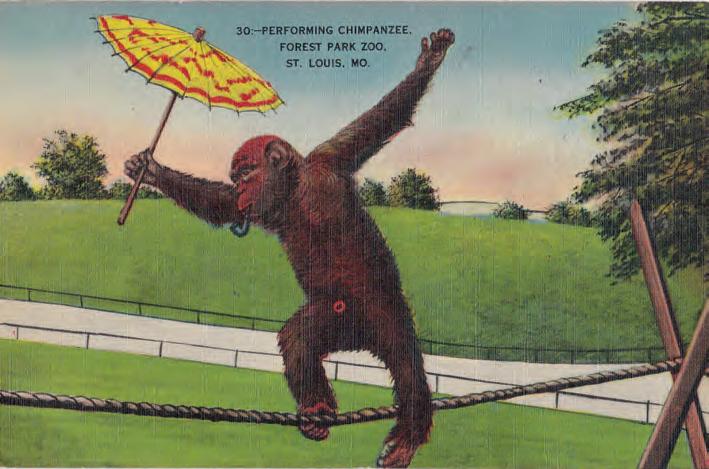
FEATURE • WHAT'S SO BAD ABOUT ZOOS 23 marthasvineyard. .com
And for nearly as long as there have been zoos, people have been worried about the animals inside them. “From the middle of the 19th century on there has been pushback about whether they're cruel places,” Rothfels said. “And that pushback has made zoos better.”
Handling a python at the New York Zoological Park.
zoo admitted on a New Zealand radio program, as thousands of human kiwis listened in.
To make matters worse, this particular bird, named ‘Paora’ after a Maori environmentalist, had hatched in Florida as part of a captive breeding program to help recover the endangered species. As one of only a few hundred kiwis living in zoos abroad with the blessing of the Maori and the New Zealand government, its treatment rose to the level of a diplomatic incident.
Incidents like these are sparks in a tinderbox of concerns about whether we should keep animals in captivity, and how they should be treated when we do. Once ignited, the whole debate goes up in a roaring blaze.
“People sometimes ask me, should there be zoos? And my answer is usually something like, well, there have always been,” Rothfels told me. He pointed out that “substantial collections of unusual animals” have been around since antiquity, for as long as people have been organized into societies with divisions of labor, leisure time, and urban centers.
And for nearly as long as there have been zoos, people have been worried about the animals inside them. “From the middle of the 19th century on there has been pushback about whether they're cruel places,” Rothfels said. “And that pushback has made zoos better.”
Zoos have incorporated people’s inherent discomfort about the treatment of animals into more sophisticated and naturalistic exhibits, starting with a German entrepreneur and animal dealer named Carl Hagenback. “He's the one who recognizes that at the end of the 19th century, people are really uncomfortable with the idea of animals behind bars, animals in cages, animals being treated badly,” Rothfels said. “Many people who visit zoos in the late

19th century are talking about the smells, are talking about how the animals don't look healthy.”
As Rothfels recounts in his book, “Savages and Beasts: The Birth of the Modern Zoo,” Hagenbeck created an enormous animal park, the Tierpark Hagenbeck, in Hamburg, moving more than a million cubic feet of soil and making his own spur on the local railroad. Rather than bars and cages, Hagenbeck designed scenic habitats separated by cleverly built ‘natural’ features and carefully placed moats, which in panorama gave the appearance of a unified landscape, with predators and prey shown together in deceptive peace.
Hagenbeck’s park was a sensation when it opened in 1907. “He creates these landscapes which are better than nature itself,” Rothfels told me. “He helped people believe that zoos could be nice places for animals.” Hagenbeck began to portray his project not as the warehouse of a commercial animal broker (which it was) but as an ark, a
sanctuary for wild animals away from the violence of nature and the depredations of humankind.
The Tierparck Hagenbeck still exists, with many of its original exhibits intact, and its illusory, naturalistic style of display is largely the one we encounter at zoos today. “Zoos make themselves more and more like our fantasy of a wild space,” Rothfels said. “The technology's getting better. The soundscapes are getting better. There's a rainforest in Vienna's Zoo where you better find a big old leaf to stand underneath when the rain hits, because you'll get completely drenched.”
Hagenbeck’s influence spread, both as a trendsetter for zoological parks (he helped redesign the Cincinnati Zoo in the same fashion) and as the most powerful animal dealer of his era, through whom many American zoos competed to acquire their animals. He had access to some of the rarest and most prized creatures on earth, and even better, “he was cash on delivery,” Rothfels said. “So you don't pay if the animal doesn't show up alive. And if it died within a reasonable time, he would say, ‘Oh, I'll just replace it.’” It was a bloody business, with mothers routinely killed to acquire their docile young, and high mortality on the long journeys to unfamiliar climates.
Hagenbeck relied on an extensive network of animal catchers, and their operations relied in turn on the extensive colonial projects of the European powers, whose grasping outposts reached to the far corners of the globe. In the early 20th century, the Smithsonian National Zoo would sometimes take a similar approach, asking diplomats and officers in US-occupied places like Panama and the Philippines to acquire live animals wherever possible.
WHAT'S SO BAD ABOUT ZOOS • FEATURE 24 MARTHA’S VINEYARD /EARLY SUMMER 2023
Zoos’ no longer function as for-profit animal dealers, and they have mostly stopped capturing animals from the wild, but the core spectacle remains. As zoos evolved from the menageries of the distant past into the civic institutions of the late 19th and 20th centuries, they became woven into the fabric of public life, increasingly at pains to demonstrate a public mission beyond mass entertainment.
“Right around the beginning of the 20th century, people start using the word ‘conservation,’” Rothfels told me. “And the key person there is William Temple Hornaday.”Hornaday, a taxidermist and zoologist, helped found both the Smithsonian’s National Zoo and then the Bronx Zoo, and went from skinning and stuffing bison for posterity to collecting live specimens and facilitating their successful reintroduction in the wild.

But this early conservation, successful though it was in some cases, came packaged alongside an obsession with purity and evolutionary hierarchy that scientists at the time applied to both animals and people, species and races. Hornaday placed a Congolese man, Ota Benga, in the primate house at the Bronx zoo, to the moral outrage of New York’s black pastors, who boycotted the zoo. Madison Grant, a co-founder of the New York Zoological Society and the Bronx Zoo and a close friend of Teddy Roosevelt, wrote a tract on eugenics called “The Passing of the Great Race” that Adolf Hitler later referred to as “his bible.”
Even before the eugenics movement came to dominate scientific discourse in the early 20th century, zoos had
realized that exhibiting so-called “primitive” people could draw big crowds. Hagenback placed Indigenous peoples alongside wildlife in various settings at his zoological park, and in Cincinnati the zoo exhibited nearly one hundred Sioux, who lived in a facsimile village there for several months.
Just as these exhibits of human beings provided fodder for the public’s lurid imagination about the hierarchy of mankind, so ideas of racial purity informed scientists’ vision of what a species should look like and how it should be restored. In a TED video, Rothfels recounts the tale of the takhi, or Przewalski’s horse, which was reintroduced into the steppes of central Asia after decades of captive breeding. Because many of its breeders had never seen this horse in the wild, and because the provenance of the original stock was so uncertain, they selected for traits that they assumed a “pure” takhi should have, meaning that the species may have been bred to match the imagination of its keepers more than the variability of the species as it once existed in the wild.
To make things more complicated, the San Diego zoo recently cloned the takhi from the cryogenically preserved cells of a stallion that died in 1998, producing two
new stallions that the zoo hopes will restore some genetic diversity to the dangerously inbred population.
The biblical ark, having two of each animal, is not a recipe for continued species viability. Wild populations require a healthy mix of genes, and animals also learn from each other, build social structures, form specialized subpopulations, and pass down epigenetic variations to their underlying genetic code — so much so that you could argue that these contextual, environmentally-specific traits are part of what make a species unique.
It’s not clear that the passenger pigeon, had it been bred successfully before going extinct in the wild, would have been able to repopulate its former range, given all the other changes in North America’s wild landscapes then and since. And it’s not clear now that species like the Florida grasshopper sparrow or the red wolf of the American Southeast will recover absent significant improvement in the conditions that brought them to the brink.
Continued on page 58
FEATURE • WHAT'S SO BAD ABOUT ZOOS 25 marthasvineyard. .com
In some ways, zoos are better for studying Homo sapiens than wild animals: They reflect and refract our desires for connection with nature, with animal intelligence, and with pre-history. How zoos move forward depends in part on these desires.
MADE ON MV
STINA SAYRE’S Sustainable Fashion PHILOSOPHY
Garments and principles to last a lifetime.
Story by Julia Cooper Photos by Randi Baird
On a gloomy, rainy afternoon in May, I walked into Stina Sayre’s shop on Main Street in Vineyard Haven. Entering the bright, modern space feels like stepping into a fashion boutique for the future. The small, modest storefront is deceiving, as the space stretches far back from the bustling main street to include racks of garments, fitting rooms, and a workspace for
making alterations. I was afraid I’d feel underdressed coming to interview Sayre about her work in the fashion industry, but I felt entirely at ease as we sat down on a small couch in the store to chat, since Sayre herself was comfortably dressed in light-washed denim jeans and a soft sweater of pastel wool.
Sayre founded Stina Sayre Design in 1989 with the mission of crafting high quality clothing that empowers its wearers to live confidently. Sayre grew up in Sweden and worked

STINA SAYRE'S SUSTAINABLE FASHION PHILOSOPHY • MADE ON MV 26 MARTHA’S VINEYARD /EARLY SUMMER 2023
Sayre drapes a mannequin with fabric.

in her family’s clothing stores before touring the world as a champion windsurfer. Her outdoorsy background influences her designs. “Growing up as a Swedish person, we have in our culture a very strong relation to nature,” says Sayre. “We’re not very ‘church’ religious, but we’re ‘nature’ religious.”
Materials and Waste

Sayre has always centered her design philosophy around valuing people, materials, and the planet. As the fashion industry and consumer expectations have shifted in the last few decades, fashion waste has increased globally. Fast fashion brands are producing twice the amount of clothes today as they were in 2000, dramatically increasing both pre- and post- production textile waste. Additionally, the number of times a garment is worn before being discarded has declined by nearly 36 percent in the last fifteen years. Calls for more sustainable practices at both the industry and consumer levels have made “sustainability” a marketable buzzword in the fashion business. “Sustainability is a big word,” Sayre says.

STINA SAYRE'S SUSTAINABLE FASHION PHILOSOPHY • MADE ON MV 28 MARTHA’S VINEYARD /EARLY SUMMER 2023
Sayre never throws away a garment. Customers can buy sample garments at markeddown prices, and even fabric scraps go to schools on the Island to be used in art projects.
Sayre believes that sustainability of people is really important: "How do I want the people who work for me to live?"
“What are we sustaining? What are we buying? Why do we buy it?”
Sayre has always made sustainability and eco-conscious design ppriorities. Though she often grapples with the pros and cons of using various materials including cotton, linen, silk, wool, bamboo, and polyester, her goal is to create high quality garments that will last the wearer decades. “If it’s a good jacket, it’s a good jacket,” Sayre says. “Even if the fabric isn’t the perfect environmental fabric, at least you have something that you’re not throwing away every month because you get bored, or it falls apart. It’s sustainable just because you’re keeping it.”
To help ensure that customers wear and keep their garments, Sayre makes any necessary alterations before a customer leaves the store. “In fast fashion, you buy something and it doesn’t fit perfectly and now you don’t wear it,” says Sayre. “We don’t let you walk out of here like that because that’s the worst advertising. We alter it, and you walk out feeling amazing."

waste is still a top priority: “If you’re small, you [might] feel like ‘well if I make ten jackets that’s not going to break the world, right?’ But if we all think like that, then it doesn’t really work.” Sayre never throws away a garment. Customers can buy sample garments at marked-down prices, and even fabric scraps go to schools on the island to be used in art projects.
The Social Politics of Sustainability
For Sayre, sustainability means more than reducing textile waste and sourcing quality fabrics. It also entails a commitment to ethical labor practices. Every garment by Stina Sayre Design is made in the state of Massachusetts by adult women who are making a living wage and choosing to sew.
As a designer, Sayre sometimes finds it challenging to source fabrics that are both best for the construction of a particular garment and best for the environment. While she prefers to use natural fibers as much as possible (and she notes that even these natural fibers have their own environmental considerations), some of her garments are made using polyester. Microplastics from polyester are shed into our water systems via washing machines. An estimated half a million tons of these contaminants reach the ocean each year. Whenever a customer purchases a garment made with polyester, Sayre tries to minimize its potential environmental harm by including a laundry bag designed to reduce the shedding of microplastics from synthetic fabrics, which also helps extend the life of the garment.
Even though in the grand scheme of the fashion industry Sayre’s production is relatively small, reducing
MADE ON MV • STINA SAYRE'S SUSTAINABLE FASHION PHILOSOPHY
29 marthasvineyard. .com
“Growing up as a Swedish person, we have in our culture a very strong relation to nature. We’re not very ‘church’ religious, but we’re ‘nature’ religious.”
Chrysal Parrot fits a jacket on Sayre.
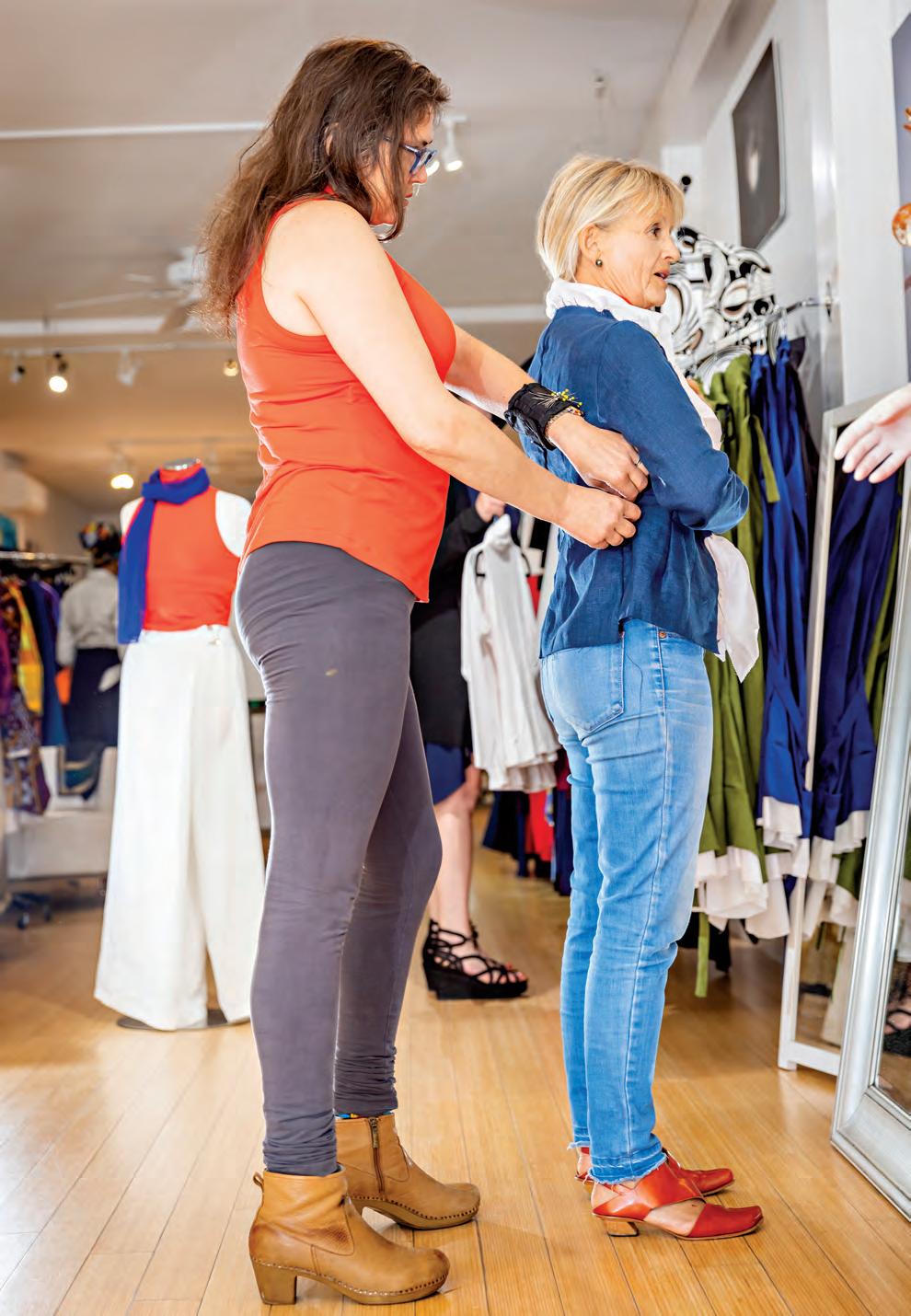
STINA SAYRE'S SUSTAINABLE FASHION PHILOSOPHY • MADE ON MV 30 MARTHA’S VINEYARD /EARLY SUMMER 2023
Fittings are done right in the studio.
“This sustainability of people I think is really important to talk about,” Sayre says “How do we live? How do I want the people who work for me to live?”

Often in the contemporary fashion economy, there can be a sense of disconnect between the consumer and the production of a garment; people don’t often think about the fact that clothing is constructed by real people with products that come from the earth. Sayre hopes that her customers are able to regain this connection through their experience with her clothing. “When you buy something here, you might be standing in line with the seamstress who made it,” Sayre says. "You belong to the community and we’re building something together.”
Sayre puts her activism in feminist movements at the forefront of her design philosophy and views women’s rights issues as necessarily entangled with issues of sustainability. “Sustaining ourselves and having power over ourselves is important,” Sayre says. “It’s about love and respect and creativity. There’s nothing more creative than love.”
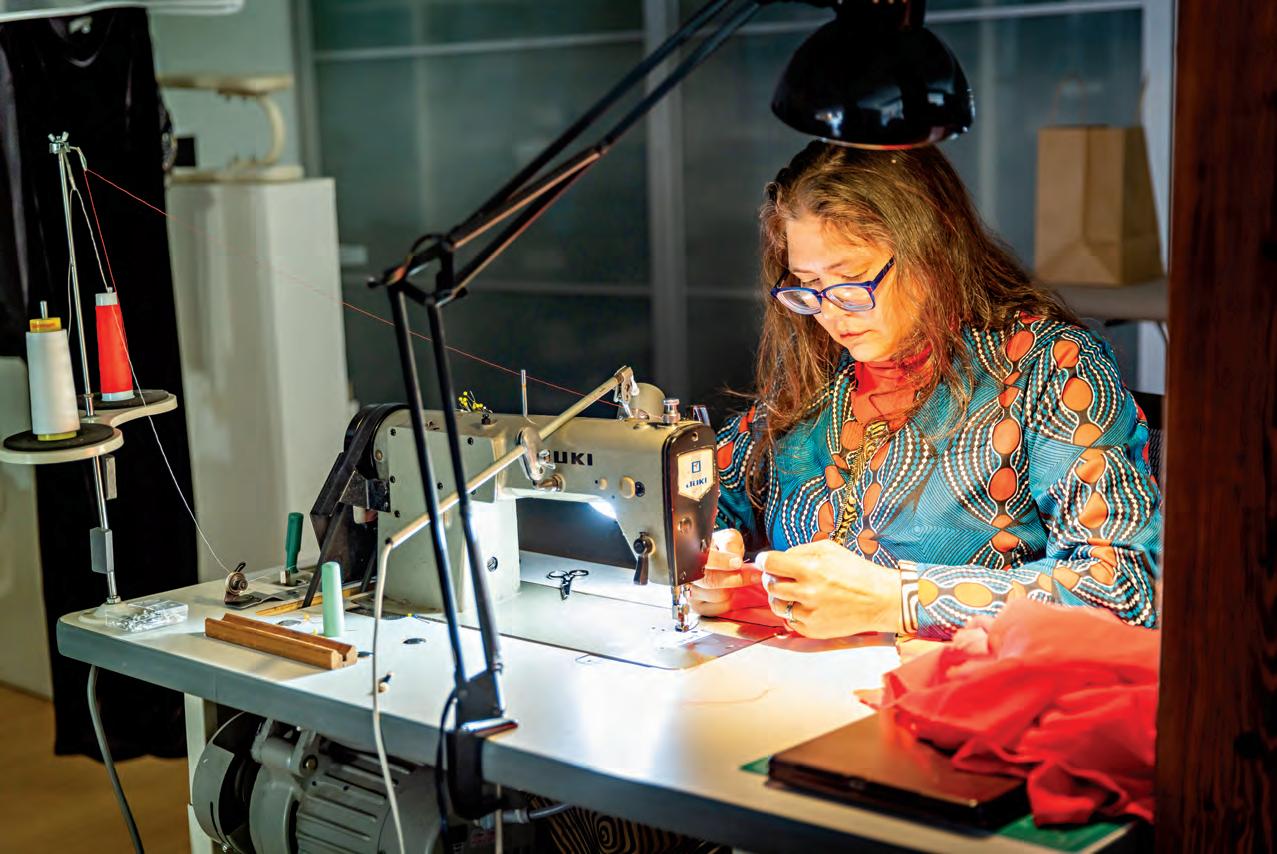
MADE ON MV • STINA SAYRE'S SUSTAINABLE FASHION PHILOSOPHY 31 marthasvineyard. .com
Sayre hopes that her customers are able to regain this connection through their experience with her clothing.
“When you buy something here, you might be standing in line with the seamstress who made it,” Sayre says. "You belong to the community and we’re building something together.”
Master seamstress and technical desiginer Chrysal Parrot at the sewing machine.

STINA SAYRE'S SUSTAINABLE FASHION PHILOSOPHY • MADE ON MV 32 MARTHA’S VINEYARD /EARLY SUMMER 2023
Left to right: Chrysal Parrot, Stina Sayre, and stylist Theresa Di Mattia at Sayre's store on Main Street, Vineyard Haven.
WHAT CAN YOU DO?
Sayre recognizes that when it comes to fashion, consumers can easily feel overwhelmed. “What’s good, what’s bad, who’s lying to me, where’s the money going? It can become a lot,” she says. Here are her tips for where to start when building a sustainable wardrobe.

Shop secondhand
“You can always go to the thrift store. That’s a great place to start.”
Invest in quality construction and timeless designs
“If you want to buy something new, start with a coat or a jacket with a classic line. Don’t spend more to spend more, spend more because when you look at it you can tell that it’s well made, that it’s good materials, and it’s going to last. The design is such that you’re not going to feel awkward in it next year.”
Pay attention to care instructions
“Your clothes will last a lot longer if you don’t put them in the machine, because that agitation doesn’t happen when you wash by hand. Also the dyes start to fade in a weird way in the laundry because the cleaning agent is so strong. If you buy something nice, take care of it.”
Join us for the "Fashion Reimagined" film, along with a discussion with the filmmaker, and a fashion show. Aug. 25, The Grange.
MADE ON MV • STINA SAYRE'S SUSTAINABLE FASHION PHILOSOPHY 33 marthasvineyard. .com
 DeVivo packs up food for the trip to Edgartown.
DeVivo packs up food for the trip to Edgartown.
WASTE NOT, WANT NOT:
Story By Catherine Walthers
When chef Jenny DeVivo arrives at the loading dock at Cronig’s on Friday at 9 am, she finds five large boxes full of food. It’s one of three days a week she “rescues” food there. For close to ten years, local nonprofits have been going to Cronig’s Market to rescue food that used to go to waste.Today, DeVivo finds a wealth of produce in very good shape: collards, broccoli, peas, potatoes, lemons, and more. In this batch, there are a couple of dragon fruits she’ll save and share with the kids for fun in the after-school program at the Edgartown Boys and Girls Club, she’ll take the food she’s collected. She sorts through each box on the spot. First, she checks some green peppers. Most look good or have a spot or two that can be removed when she cuts them up. She doesn’t take anything she won’t use, so she tosses a few into the Cronig’s compost bin. Today, because she knows she has plenty of frozen bread, she leaves a box of Pain D'Avignon multi-grain loaves and baguettes that were tossed to make room for the new bread that comes in daily. There are some yogurt six-packs missing one yogurt and cereal boxes with a tear in the box. The predominant haul consists of some two dozen boxes of mixed baby lettuces, arugula, and spinach. The arugula looks bright green and fluffy. Much of this food has been stamped with “best if used by" or "buy-before" dates, and grocery stores discard items once those dates have been reached. But according to manufacturers and the FDA, these dates indicate peak quality, not safety. (Read more about food labels here: bit. ly/FDA-food-labels.) “There’s so much misunderstanding of what’s good and what’s bad,” says DeVivo. “The waste is mind-boggling."
Jenny DeVivo Rescues Food
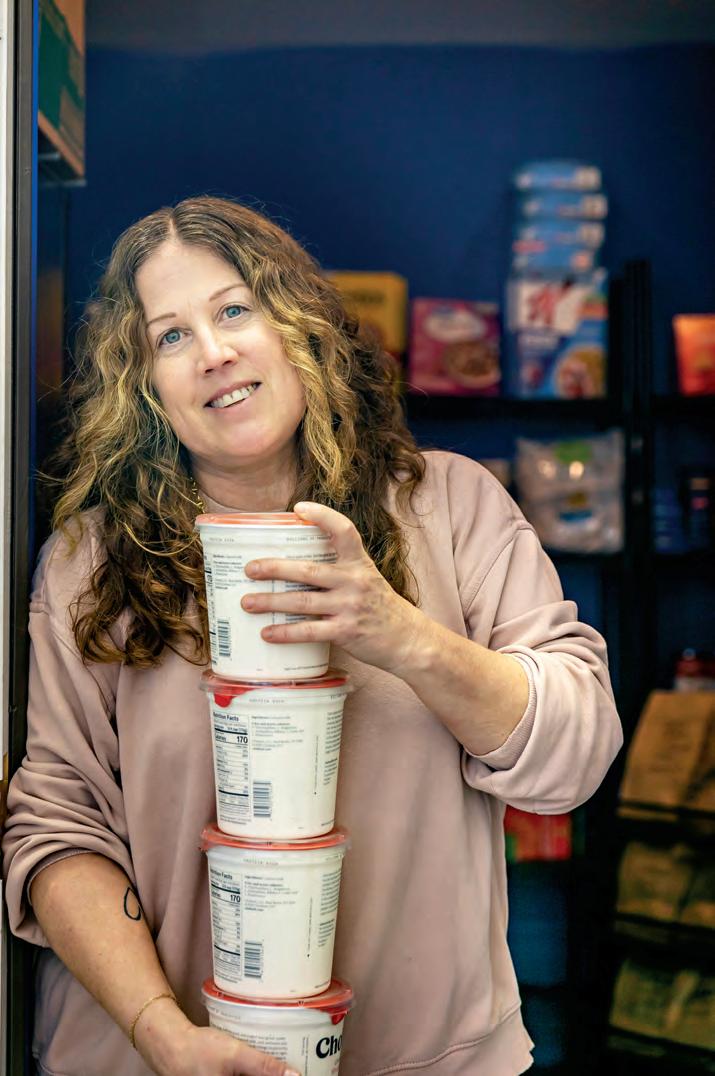
Another source of what she and other island rescuers find are so-called “mispicks.” These are deliveries of food the grocery store did not order and does not regularly carry, so the items don’t register in its computerized shelving and pricing system. That’s how six cases of granola bars with a September 6 sell-by date ended up on the back door loading dock to give away. Cronig’s
Steve Bernier, now a store employee, says the volume of potential waste has only increased since the pandemic. He points to skyrocketing errors, inefficiency, and lack of employees at distribution sites where food comes from. “We’re trying to make lemonade and to think positively,” Bernier says. "So it’s working in some crazy way to get things to the back door to help people. It feels better.”
FEATURE • JENNY DEVIVO RESCUES FOOD 35 marthasvineyard. .com
former owner
With food that would have gone to waste, DeVivo stocks pantries and fridges at the Boys and Girls Club.
Photos by Randi Baird
Too Good to Go
DeVivo never knows what might be waiting for her from week to week on one of her three assigned pick-up days. "I kind of treat everything a little like an adventure," she says. Today she finds several Pie Chicks pies, made with care in the bakery just feet away from Cronig's. Pie Chicks owner Chrissy Kinsman says the pies get stamped with a date four days from when they are baked. After that, Cronig’s employees direct any unsold pies to the back door loading dock. “Jenny is committed to rescuing food, and she is willing to put in the time and effort,” says Carol, a long-time
volunteer who helps coordinate the weekly rescue food pickups and deliveries from Cronig’s. “She cares about the quality of food people get, and she cares about food waste.” Steve Bernier is more than happy to see this good food get used, rather than being tossed. “I see Jen with her passion and her drive," he says. "She and others are leading us down this path, and it’s our job to listen about how to do it. It’s a beautiful journey."
DeVivo started rescuing food when she was head school chef at the West Tisbury School, a position she held for ten years. There, she and others helped transform kids’ lunches from canned
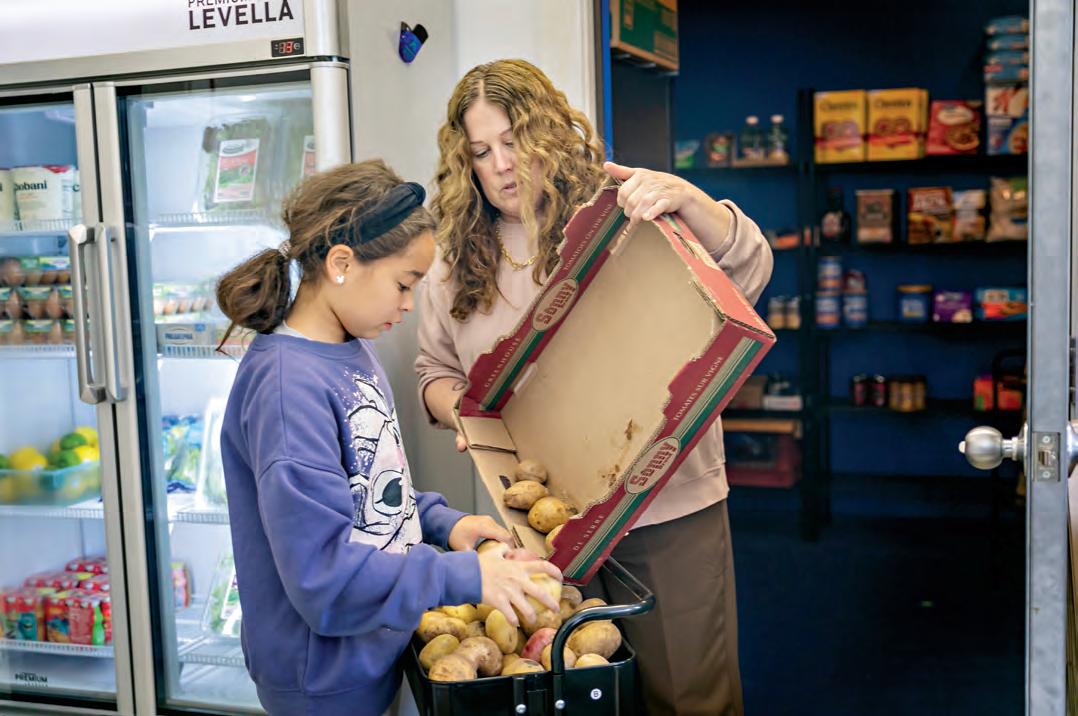
Some of the food will become snacks for the kids; some will go into the "Blue Door Pantry," which is free to all 267 members to take home.
and institutional foods that arrived on a truck to fresh and nutritious meals cooked from scratch. She supplemented these meals with local and sustainably produced food from Vineyard farms, locally donated fresh fish, and rescued produce — exactly what she now does at the Boys and Girls Club. "Everyday, I love it more," she says about her mission. “Rescuing perfect, healthy, delicious food is what I love to do.” Some of her instagram taglines tell the story of her food recovery even better: #SavetheFood, #TooGoodtoGo, #RethinkFood, #SustainableFood, and #GoodFoodforGood.
When she arrives back at the Boys and Girls Club, Jenny makes a number of decisions about how the food she’s rescued will be allocated and used. Some of it will go toward the preparation of two snacks for the eighty to eighty-five Island students who come in after school every day. Some will go into the club’s “Blue Door Pantry,” where food is free to all of its 267 mem-
JENNY DEVIVO RESCUES FOOD • FEATURE 36 MARTHA’S VINEYARD /EARLY SUMMER 2023
“Jenny is committed to rescuing food, and she is willing to put in the time and effort. She cares about the quality of food people get, and she cares about food waste.”
– Carol, a food rescue volunteer and coordinator

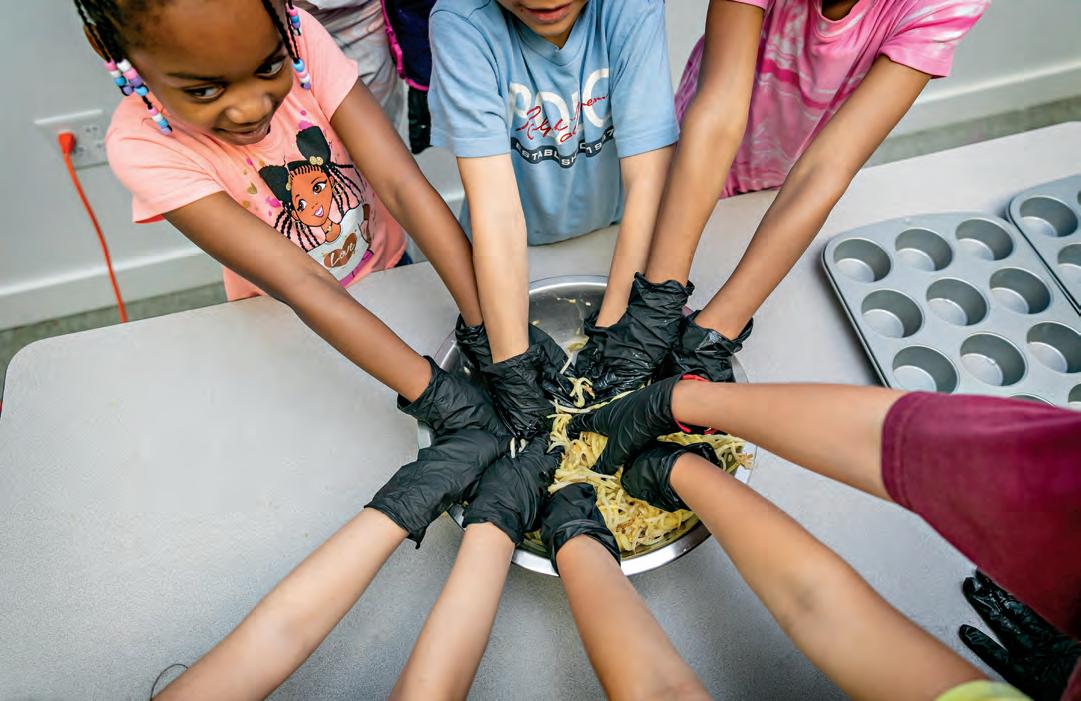


FEATURE • JENNY DEVIVO RESCUES FOOD 37 marthasvineyard. .com
It's all hands on deck to help prepare the food.

bers. And some will stock two “Grab & Go” refrigerators at the club entrance; parents who pass by when dropping kids off or picking them up can take fresh foods or prepared meals, free of charge. When Dhakir Warren, a former vice principal at the MV regional high school, became executive director of the club in 2021, he decided to widen the availability of healthy and nutritious foods not only to the kids when they’re at the club, but also to their families.
Cronig’s is a prime source, but farms like Grey Barn, Slough Farm, Morning Glory, and others contribute as well. Today’s meal includes Vineyard-raised organic bratwurst donated by the Grey Barn in Chilmark. Farm owner Eric Glasgow contributed the bratwurst, a type of German sausage made from pork, straight from the freezer because he was simplifying the farm’s offerings
and discontinuing the bratwurst. “So it was great Jenny was in a position to take all that I had on hand,” Glasgow says. DeVivo combined the bratwurst with rescued kale, potatoes, and sauerkraut — an example of a one hundred percent rescued meal. A previous pasta dinner this week featured fresh artichokes and eggplant collected from Cronig’s and then roasted and mixed
On this day, the fresh foods families can choose from include Bolthouse OJ, containers of Camembert cheese, cut up broccolini or cauliflower, and the boxed lettuces. “The best part is that they can get fresh produce they maybe can’t normally afford,” DeVivo says. (Boxed baby spinach and lettuces are priced at $7.49 in the supermarket, and Bolthouse juice retails for $10.99 a quart.) She lets families know what’s available and answers questions daily, passing along her knowledge and experience. “We discuss the sell-by dates, how to reheat, how to freeze, or suggestions on food preparation. It varies, depending on what is in the fridge."
A Community Effort
Rescued food constitutes between forty and one hundred percent of each day’s prepared snacks and meals at the club.

FEATURE • JENNY DEVIVO RESCUES FOOD 39 marthasvineyard. .com
“I see Jen with her passion and her drive. She and others are leading us down this path, and it’s our job to listen about how to do it. It’s a beautiful journey.”
–Steve Bernier, Cronig’s former owner
Rescued food constitutes between forty and one hundred percent of each day's prepared snacks and meals.
with pesto. Yesterday’s rescued flatbreads and tomato sauce turned into pizzas (though DeVivo purchased the cheese toppings). Dessert might be a Pie Chicks pie or some crispy, tasty Tate’s-brand cookies from the Katama General Store, which had just dropped off a large unopened cardboard box filled with bags of Tate’s gluten-free chocolate chip cookies. When she gets too much food, DeVivo freezes it –usually all sliced and diced, ready to be roasted or sauteed. “The freezer is my best friend,” she notes. Yogurt or milk with sell-by dates, as well as rescued strawberries or blueberries, get frozen for smoothies. DeVivo thinks on her feet, since each day brings different ingredients. For today’s snack, she decides on French toast with the eggs she’s collected and bread from the freezer, served with some bacon. Tomorrow it could be tacos, depending on what’s come in.
A Tiny Kitchen with a Big Heart
When the Boys and Girls club started serving Island youth in 1938, its founders probably never imagined 800 to 900

meals would be cooked in the kitchen each week — some 30,000 meals just since last October. DeVivo accomplishes this in a rather tiny, 230-square-foot kitchen, equipped with two portable, plug-in induction burners, a small kitchen sink, and very little counter space. Luckily, it has a commercial oven with multiple shelves.
The chef, staff, and director are all very much looking forward to breaking ground on a new 25,000-squarefoot club building, either this coming September or in the spring of 2024. Director Warren says that most everything in the current 11,000-square foot space is outdated and frayed at the edges. The club’s capital campaign raised roughly $10 million for a building estimated to cost $10.5 to $12 million. Now, with an inflated economy and rising construction costs everywhere, the price tag has risen to over $15 million, and the club must scramble to raise the additional money. The new building will have a commercial kitchen double the size of the current one, space to teach cooking classes, and other updates including a STEAM (Science, Tech, Engineering,
Arts, Math) lab, a digital tech center, and an arts studio.
The Blue Door Pantry
With food prices soaring since Covid and housing costs climbing, Warren said that he and the staff noticed families becoming even more stretched. After he implemented the Grab & Go fridges, DeVivo helped him launch the pantry when she began working at the club in 2022. “From taking my vision for a food pantry and bringing it to life, stocking, partnering and management, soups to nuts, Jen has played a critical role in taking this food project to the next level,” Warren says. The Blue Door Pantry, located for the time being in an extra closet space, opens from 4 to 6 pm each Wednesday and Friday for club members to pick up non-perishable food items as well as some essential hygiene products provided to the club at wholesale costs. Warren calls it one-stop shopping, and says it can help eliminate the choice for some members between buying toothpaste or buying milk. "It’s an added resource for our club members, and it helps support food security among our community,” DeVivo says.

JENNY DEVIVO RESCUES FOOD • FEATURE 40 MARTHA’S VINEYARD /EARLY SUMMER 2023
The bounty includes groceries from all over the Island, and sometimes even Pie Chicks pies.
Students and the Future
Along with ensuring good nutrition for kids in the after-school program each day, DeVivo likes to involve the students in any aspects of her work that interest them. In between academic work and sports, they might prep in the kitchen or help set up the pantry. When I offered to process the boxes of fresh strawberries from Cronig’s that day, DeVivo said that’s
a task the kids like to do. The few dozen potatoes that came in Friday's rescue were used in Monday’s cooking class. Students watched as Jenny used a food processor to shred the potatoes, then donned protective gloves to mix in eggs and flour and nestle the mix in muffin trays for "potato bird nests." After baking, they sampled their work. "I want the parents to feel that their kids are cared for after school,"
says DeVivo. And she wants kids to see all aspects of where food comes from, how it’s cooked, and how not to waste food. She and Warren say the club plans next to launch a mobile classroom food truck. They’ll bring the food truck/bus to farms, fish markets, and other food purveyors. "It’s a culinary classroom that’s going to connect children to their local food sources," DeVivo explains.

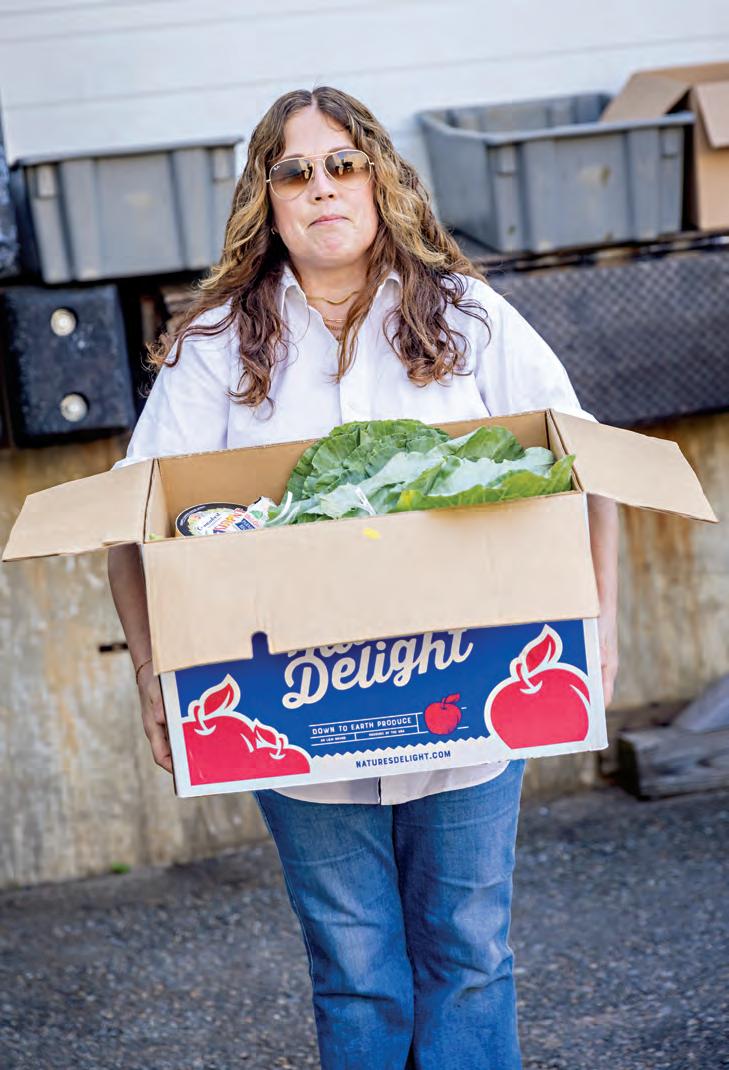

Some of Jenny DeVivo’s instagram taglines tell the story of her food recovery perfectly: #SavetheFood, #TooGoodtoGo, #RethinkFood, #SustainableFood and #GoodFoodforGood.

FEATURE • JENNY DEVIVO RESCUES FOOD
41 marthasvineyard. .com
Garden to Table,
Gardening for Year-Round Eating
 Story by Laura D. Roosevelt
Story by Laura D. Roosevelt
Time to plant tomato, basil, parsley, and other seedlings.
Photo courtesy Shutterstock
Last year at this time (I’m writing this in mid-May), I had just embarked on a new vegetable gardening plan: I wanted to modify what I planted so that my garden could play a larger role in feeding my husband and me all year long. I wanted to do what I could, in my small way, to reduce the environmental impact inherent in eating grocery store vegetables that have traveled many miles in fuel-burning trucks. I started small, supplementing my normal summertime planting with extra quantities of about ten things I knew would last through the winter. I could store onions, garlic, and butternut squash in my cool basement. I could freeze sugar snap peas and string beans. I could pickle cucumbers and shishito peppers. And a few things could even be preserved in the garden itself: kale, collard greens, leeks, and parsley will sometimes overwinter. (Last year, they lasted until the big freeze we had in late January, when temperatures dropped well below zero.)
I learned a few things over the course of the year that I’m applying to my planning for this summer’s garden:
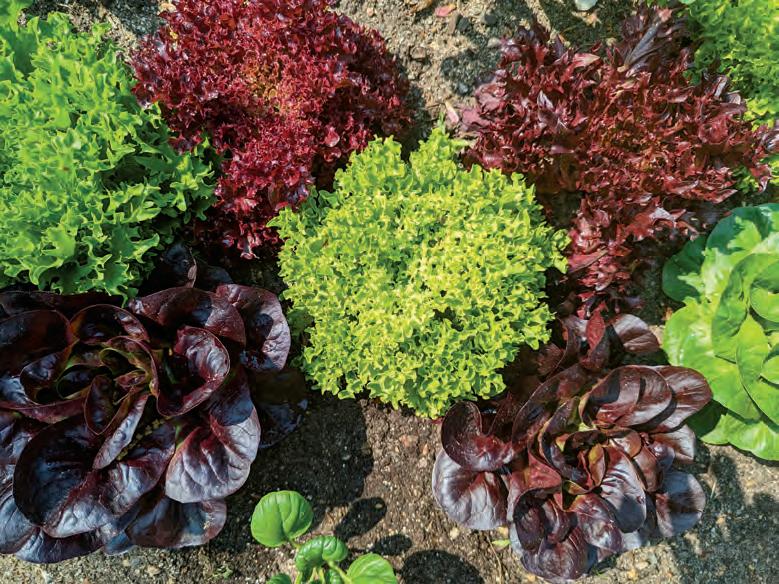
1) It turns out that we don’t like pickled shishitos, but my cucumber pickles were fabulous — we want more of those.
2) We don’t need as many winter squashes; I stored about twenty, and five eventually rotted.
3) We could use more frozen sugar snaps and string beans. They’re great in salads, stir-fries, soups, and even eaten just by themselves, briefly zapped in the microwave.
4) The larger the onion, the faster it sprouts and rots, so eat the big ones first.
5) You actually can have too much garlic. If ours from last year doesn’t dry out or start sprouting (which, amazingly, it hasn’t yet), we might be still eating it when we harvest our next crop in July.
6) The chipmunk population exploded last year. Our new dog may well solve the problem that lost me so many of last year’s tomatoes that I didn’t have enough for canning. Freddie, our poodle-mix rescue pup, wouldn’t hurt a flea, but he loves chasing the chipmunks for sport, so I’m using him for pest control, in hopes that he’ll harass the varmints enough that
they’ll decide to move to calmer shores. So far, it seems to be working.
I’ve also realized that my planting last year didn’t take into account the extra fridge in our basement. Most root crops (beets, carrots, kohlrabi, celeriac, daikon radishes) will store for many months in the fridge, so this year, I’m allocating more garden space to a variety of them (not including turnips and rutabagas, which I like but my husband hates). Cabbage, while not a root vegetable, also lasts forever in a fridge, and it’s wonderfully versatile — delicious raw in salads, cooked in soups and stir-fries, or even tossed in a little coconut oil and salt and roasted in the oven. So, note to self: more cabbages this year. (And by the way, we grow mainly purple cabbage, because, as is true with darker vegetable varieties in general, purple cabbage is considerably more nutritious than its lighter-colored counterpart. For starters, purple cabbage contains ten times the vitamin A and twice the iron of green cabbage.)
By the time this issue of Bluedot Living hits the stands, you’ll be picking your sugar snap peas, which of course, if you read my gardening article in the last issue (bit.ly/ spring-garden-mv), you remembered to put into the ground before the end of April. I
hope you used my tip about soaking the seeds overnight in water, then folding them into dampened newspaper for a few days to get them to sprout. This methodology eliminates the planting of non-sprouting seeds (there are always a few in every packet) and also gives the peas a head start when you put them in the ground, so the vines will emerge faster and start climbing their trellises.
GARDENING FOR YEAR-ROUND EATING • GARDEN TO TABLE 43 marthasvineyard. .com
L
You actually can have too much garlic. If ours from last year doesn’t dry out or start sprouting (which, amazingly, it hasn’t yet), we might be still eating it when we harvest our next crop in July.
Lettuces from Laura's garden.
PHOTO BY LAURA D. ROOSEVELT
If, indeed, you are now picking sugar snaps, and you find yourself with some to spare, freezing them is a breeze. They must be parboiled first, to kill off the enzymes that lead to decomposition. This link (bit. ly/Sugar-snaps) provides excellent, stepby-step instructions for the entire freezing process, though I disagree with them on one point: they recommend boiling for 90 seconds, but in my experience, this is overcooking and leads to mushier peas once you thaw them. Last summer, I boiled my peas for 30 seconds, and it seemed to do the trick, since they came out of the freezer still green but not soggy.
Like sugar snaps, onions should already be planted by now for best results. They like getting started in cool weather. But planting either seedlings or “starts” (small bulbs) now will still
produce onions — just smaller ones than if you’d begun earlier.
So, what should you be planting now? Tomato seedlings. Basil, parsley, and other herb seedlings. Don’t bother with radishes for the time being, since most varieties don’t do well once the weather gets hot (they grow leaves, but the roots are often skinny and tough). But fear not: You can plant them again in late summer when it’s cooling down, and like other root vegetables, they will preserve well in the fridge. It’s also too late to plant lettuce if you want full heads, because in hot weather, lettuce grows spindly and tall and goes to flower quickly. You can, however, still pick its leaves (and those of arugula) when it’s young and small, but you need to plant a lot of seeds to get enough for a few salads. And again, planting later in the season when the temperatures are dropping will give you heads of lettuce in the fall.
Now is the time to start (or continue) planting root vegetable seeds. It’s a good idea with these to plant successive crops so you’ll have mature vegetables to pick throughout the summer and fall — and perhaps some extras to store for the winter. Read the backs of your seed packets to learn the number of estimated days to maturity, and keep planting every couple
of weeks until the maturity date is around the end of October.
Now is also the time to get your string beans into the ground —successive plantings of these are also a good idea — and plant lima beans. I’ve said this before, and I’ll say it again: You think you don’t like lima beans, but you will. Freshly picked lima beans, harvested when they’re still tender and on the small side, are delicious. Steam them briefly, then toss with a little butter, a pinch of salt, and some chopped chives and tarragon — you’ll thank me. Or briefly boil them with some fresh corn kernels, then toss with chopped fresh basil, salt, and olive oil — yum. Make sure you get those limas in the ground asap, because they take over two months to mature. Twice I’ve tried planting the climbing variety at the end of July after removing my sugar snap vines, and both times, I got towering, robust vines, and no pods. Declining sunlight may have been a factor; limas need about 10 hours of good sun a day to produce pods. I also wonder whether the number of pollinators drops off when the weather cools; my vines had some blossoms, but no pods.
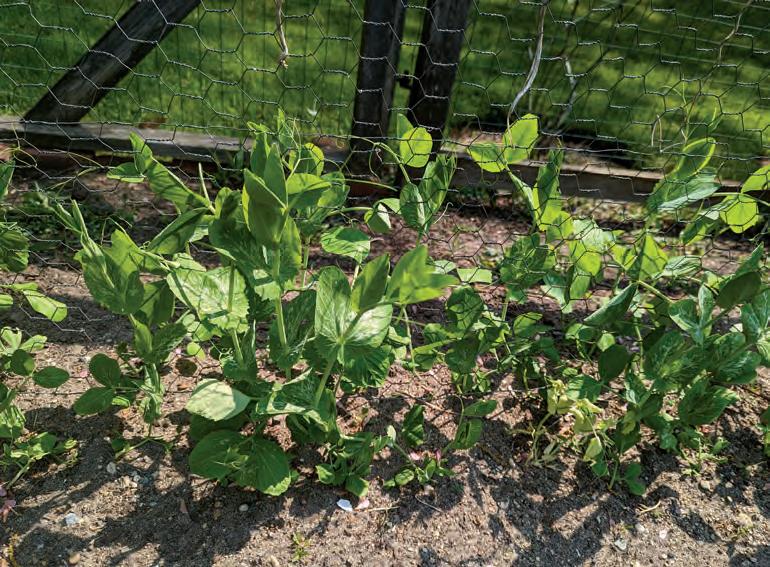
I hope your squashes and cucumbers are already in the ground, but it’s not too late to plant seedlings from one of the local nurseries. If you’re a fan of zucchini blossoms, all you need to know is that each plant will produce male and female blossoms. The females will flower on the ends of teensy baby squashes, whereas the males grow on stems. Pick the male blossoms for deep frying, stuffing, or chopping up in salads. Leave the females to mature into squashes.
I’ve never tried doing successive plantings of zucchini. Evidently some people do, but I can’t imagine why. Zucchini are vigorous producers — so vigorous that most of us wind up with far more than we can possibly use. And zucchinis mature so quickly that you can practically see them getting larger while you watch. Gardeners joke about getting rid of extra zucchini by dropping some off in random strangers’ cars, or
GARDEN TO TABLE • GARDENING FOR YEAR-ROUND EATING 44 MARTHA’S VINEYARD /EARLY SUMMER 2023
Zucchinis mature so quickly that you can practically see them getting larger while you watch.
Sugar snaps climbing their trellis.
PHOTOS BY LAURA D. ROOSEVELT
leaving a huge pile of the overgrown ones (they can get absolutely enormous if you forget to pick for four or five days) on the doorstep of somebody one doesn’t much like. My preferred strategy has been finding unexpected recipes that incorporate zucchini. My favorite from last summer was turkey zucchini burgers spiced with cumin, coriander, and chili powder. There are many recipes for turkey zucchini burgers online. Try one that sounds good to you, and then maybe try another!
You will note that I don’t talk about planting corn. There are three reasons for this: First, it takes up a huge amount of space. Second, raccoons (who can easily climb over any deer-proofing fence) love it and can completely devour your crop, literally overnight. This happened to me the one year I tried growing corn. One morning, a day or two before I would have considered the corn ready to pick, I came out to my garden to find every single ear still on the stalk but stripped of its husks and eaten down to the cob. I had three twelve-foot rows of corn, and not one uneaten ear remained. That was a dark moment in gardening. Fortunately, there’s reason number three for not planting corn: Here on Martha’s Vineyard, the corn at Morning Glory Farm is plentiful and absolutely delicious. If you’re not on the Island, check your local farmers market.
I’ll end by talking a bit about weeds. They are unavoidable, but there are things you can do to mitigate them. I


lay down straw between my beds, and where appropriate, I cover beds in black garden paper that’s thick enough to keep weeds from growing through it, but porous enough to allow water in. I use it on the beds in which I’m planting seedlings; I cut out little circles just large enough to fit each plant. Weeds will still manage to grow in those little exposed circles of dirt, but they’re relatively easy to manage. Of course, paper doesn’t make sense for crops like carrots and
beets, because you’re planting multiple seeds fairly close together.
Last summer, I finally accepted that some part of every day in the garden must be spent pulling weeds. I drop them right on top of the straw between beds, and after a few days in the sun, they become something like more straw, which the worms slowly eat away, and which biodegrades completely over the winter while I’m inside, happily eating last summer’s bounty.
45 marthasvineyard. .com
GARDENING FOR YEAR-ROUND EATING • GARDEN TO TABLE
I had three twelvefoot rows of corn, and not one uneaten ear remained. That was a dark moment in gardening.
One of two long beds of onion seedlings.
Cruising with Currier Currier
JESSICA MASON AND HER MEAL-MOBILE
Written by Lucas Thors Photos by Sheny Leon
WOur writer spends the day as a fly on the dash of an important new venture.
When I was asked to pinch hit for the one-and-only Geoff Currier for an installment of his Cruising with Currier series, I knew it would be a fun and challenging experience. Geoff really gets to the meat of the story when he rides around with all these fascinating folks. When I walked up to Jessica Mason of Island Eats, who was parked in the West Tisbury library parking lot, the first thought that
flashed into my head was “What would Geoff do?” The second thought was “Wow, what a cool Volvo.”
Mason is the creator of Island Eats, a program that seeks to reduce and eventually eliminate the material waste that comes from the food service industry on the Vineyard. It’s a big goal, but Mason is taking the necessary
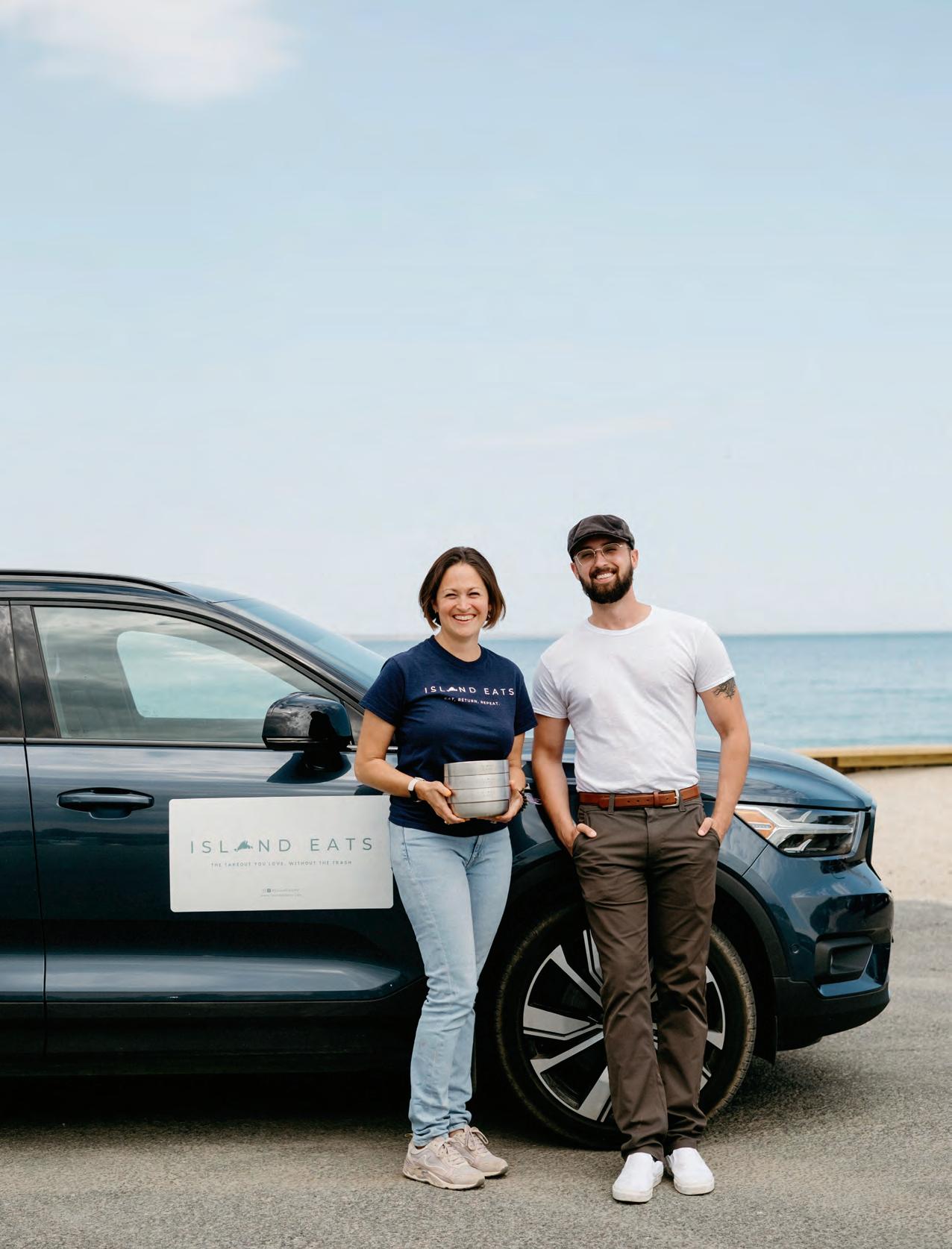
first steps. So how does an individual approach such a major problem? “Climate change and environmental protection can feel really daunting, like something that is impossible to solve,” Mason said. “Many of us want to do something to make a difference, but it’s hard to know where to start when it seems like the system is really stacked against us.”
Mason first thought about how she could empower folks to begin making
CRUISING WITH CURRIER • MASON 46 MARTHA’S VINEYARD /EARLY SUMMER 2023
Jessica Mason and pinch hitter Lucas Thors with the meal-mobile in Menemsha.
environmentally-conscious decisions in their day-to-day lives. She decided to start by addressing the number one export from the Island — trash. During the pandemic, the Vineyard saw a drastic increase in the number of takeout containers being used, and Mason observed that even the so-called “compostable” containers were just being chucked in the garbage. Although scrutiny from environmental organizations and members of the public has caused most restaurants and businesses to start carrying cardboard (compostable) containers, Mason explained that those containers are lined with plastic that does not biodegrade. While theoretically a better alternative to plastic, these cardboard boxes do not break down in home compost, and the only composting facility here doesn’t accept those kinds of containers.
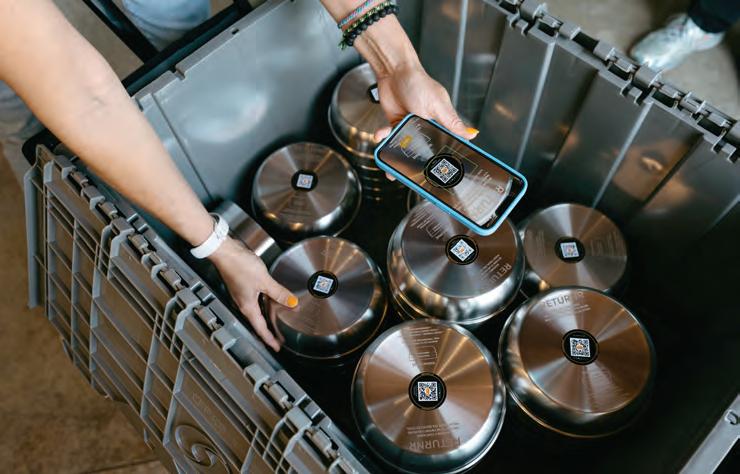
Through this realization, Mason started researching reuse systems in other places around the world, and quickly discovered that reuse isn’t a new concept, “it’s just new to the Island” she said. Even though plastic reusable containers are ubiquitous in the takeout industry, Mason said it was clear to her that switching over from single-use plastics to multi-use plastics would not be a sustainable solution. “We are still supporting the petrochemical industry, and we are still increasing the number of plastic containers that are produced. I heard from people early on that this would not be something they would support,” Mason said.

And that’s how Mason arrived at her beautiful double-walled stainless steel takeout containers as the centerpiece of her Island Eats operation. The containers that Island Eats circulates in the community are made of 75 percent recycled stainless steel (the rest is nonrecycled) that insulates well and is extremely durable. Currently, they only have a single size bowl (40 ounces) that is versatile for many different meal sizes and types. The initiative is just a year in, and there are more ideas in the works, like introducing a soup container or sushi trays. Now, rather than buying a soda from a restaurant and enjoying it in a plastic or paper cup, folks can use the
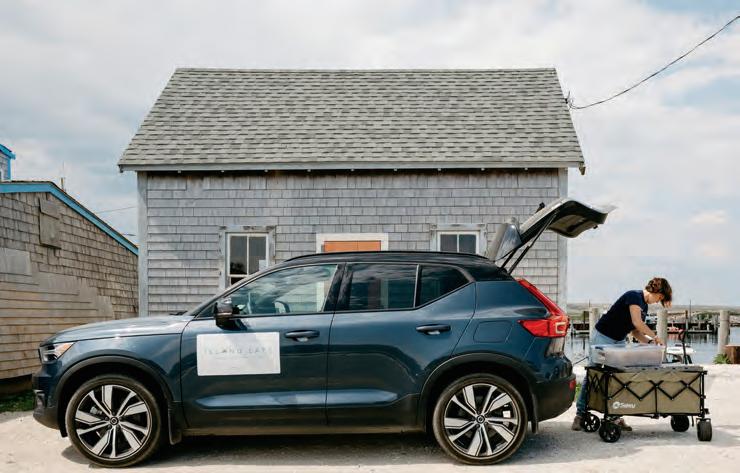
MASON • CRUISING WITH CURRIER 47 marthasvineyard. .com
Keeping track of bowls is as simple as scanning a QR code.
Betsy Larsen, left, helps Mason with Island Eats bowls.
Mason unloads freshly cleaned Island Eats bowls.
Island Eats system to get their beverages in 12- or 16-ounce stainless steel reusable mugs. Mason said it’s all part of giving people the opportunity to make a more sustainable choice.
The easiest way to explain Island Eats is that it’s like a library system. Folks have the ability to borrow the bowls from any participating restaurant, enjoy their food, then return the bowls to any restaurant that’s involved in the program. Users first download a phone app, called Useful, and then they have the option to enter into either a free membership or a paid membership. The free membership gives you access to the program, but you need to return your bowl (or mug) within twentyfour hours. The paid membership allows you seven days to return your bowl. Island
Eats offers monthlong, summerlong, or annual paid memberships.
During my sunny ride-along with Mason in her hybrid Volvo XC40, we drove the Menemsha route, delivering bowls to the Menemsha Fish Market and Larsen’s Fish Market. We also picked up the dirty bowls, which will go to a commercial cleaning facility to be made sparkly and sanitary and ready to be redistributed. Island Eats’ system uses a QR code at the bottom of each bowl that allows Mason to track where each bowl is on the Island, and whether a restaurant needs a new batch of bowls. By June, Mason expects that around twenty restaurants will be enrolled in the reuse program. For Mason, having a hybrid vehicle for her program is all part of her

48 MARTHA’S VINEYARD /EARLY SUMMER 2023
Mason first thought about how she could empower folks to begin making environmentallyconscious decisions in their day-to-day lives. She decided to start by addressing the number one export from the Island — trash.
CRUISING WITH CURRIER • MASON
Mason in front of Menemsha Fish market, getting ready to haul containers back to the car.
broader investment in sustainability and green initiatives. “I absolutely love this car,” Mason said. “It’s comfortable and incredibly fuel-efficient, which is important when I am driving all around the Island delivering and collecting bowls.” Mason’s XC40 has some pretty cool features, like a 360-degree camera, supportive driver assistance that makes
regulation could be altered, it would essentially mean that Island Eats no longer has to exist. “That would be a wonderful thing. I am doing this to solve a problem we are facing now, but the systemic solution is to actually create policy at the state level,” Mason said.
Although there is no cost to restaurants that want to be a part of the Island Eats

philanthropy and consumers deciding to choose paid memberships will balance the system and allow Island Eats to continue its good work.

After leaving the fish markets in Menemsha, Mason said the many partnerships Island Eats already has are a testament to the strength of community — to the kinds of amazing things our community can do when we work together. “I’m really energized when I go into a restaurant or business, and I see how excited and proud people are to be a part of this,” Mason said. “It’s really fullcircle for me, because Betsy [Larsen] and Stanley [Larsen] have known me since I was a baby, and now I am partnering with them to do something really important.”
subtle adjustments as she drives, and an advanced cabin air filter. Altogether, it’s a pretty sweet and sustainable ride with plenty of space to accommodate Mason, our photographer, myself, and hundreds of stainless steel bowls.
There’s another pretty amazing perk to the Island Eats program: Mason can track the environmental impact users are having restaurant-by-restaurant, as well as at a systemwide level that provides a comprehensive overview of how much trash has been eliminated. “As we work with these restaurants, we are talking to them about sustainability and making suggestions for things they can do to lessen their environmental footprint,” Mason explained. “One of the easiest things they can do is stop posting photos on social media of food in these disposable containers. Normalizing the use of reusables is essential.” Island Eats users can also view their own individual reuse dashboard on the Useful app; it’s pretty empowering to see how much impact just choosing a reusable takeout container can make.
For Mason, top-down change is another important aspect of adjusting the paradigm around waste from the food service industry. Because board of health rules ban outside containers in a food preparation facility, no businesses on-Island allow folks to bring their own reusable containers. If, at the state level,
initiative, most partner businesses have agreed to offer a dollar off any item that customers get in a reusable Island Eats bowl. Mason hopes that will provide a good incentive to consumers to adopt this important practice. “[In] many other systems around the world that have seen success in this, the restaurants must bear the cost of participation,” Mason said. “We recognize that most Island restaurants have a very short season, so we are making it completely free.” Mason hopes that a combination of
Mason’s dream for the Island is to broadly implement reuse in all restaurants, grocery stores, farm stands, and more. “We want reusable containers to become the standard, so that when someone goes into a restaurant and asks for a singleuse container, that becomes the outlier,” Mason said. “We want folks to step in and say ‘hey, here on the Island we embrace reuse — we have a different way of doing things, and we invite you to join us.’”
Sign up for Island Eats at islandeatsmv.com
MASON • CRUISING WITH CURRIER 49 marthasvineyard. .com
Island Eats is like a library system. Folks have the ability to borrow the bowls from any participating restaurant, enjoy their food, then return the bowls to any restaurant that’s involved in the program.
Stanley Larsen grabs some clean bowls for his hungry customers.
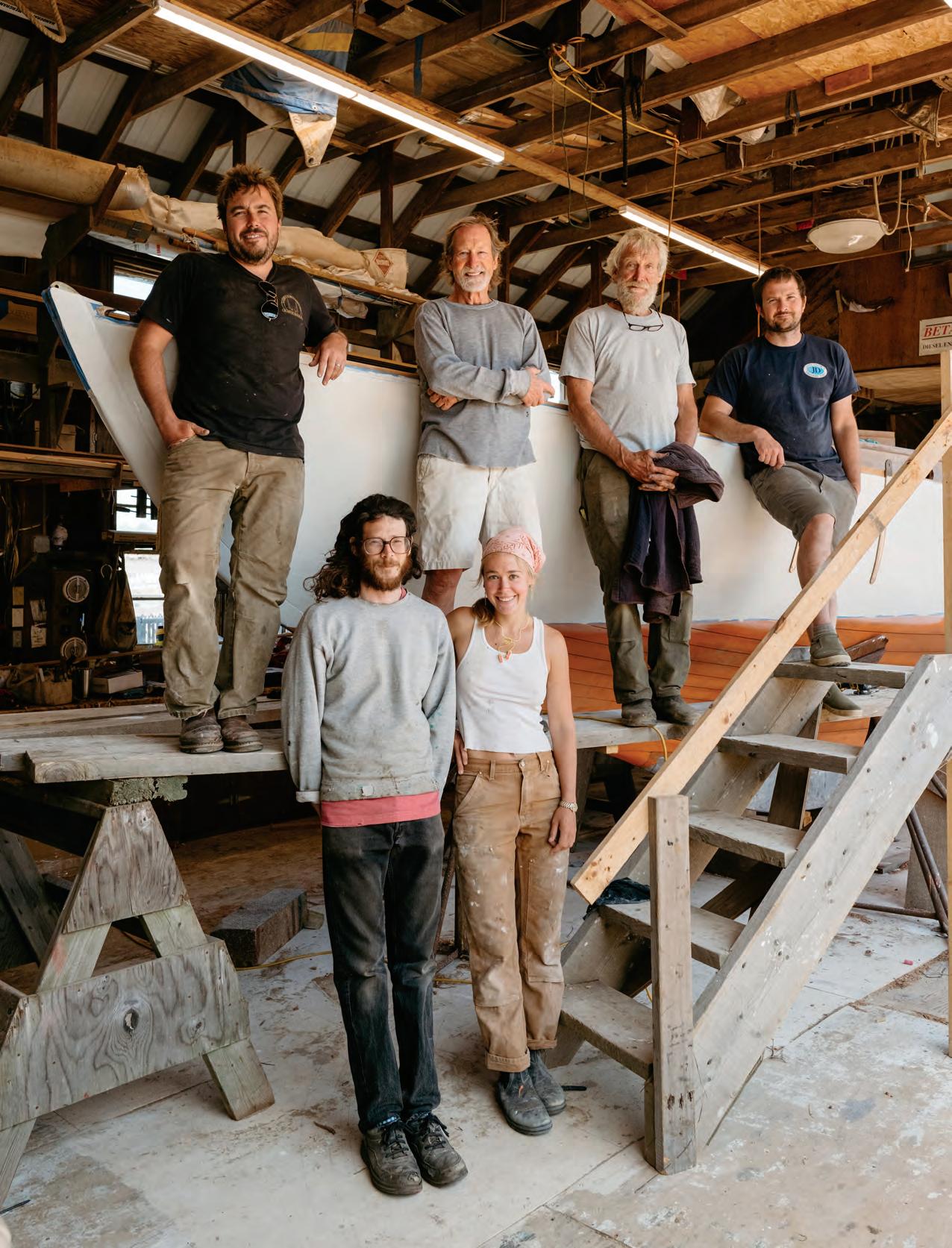
SOLAR-POWERED BOAT • FEATURE 50 MARTHA’S VINEYARD /EARLY SUMMER 2023
The G & B crew who worked on Marta: Top, Lyle Zell, Nat Benjamin, Ross Gannon, Andy Chapman. Bottom: Harry Ricciardi, Greta Gannon.
PHOTO BY SHENY LEON
MADE ON MV
Two ‘Hippie Carpenters’ Make Their 100th Boat
When the world was smaller, harbors all had different boats. Suited to the bodies of water they crossed and worked, boats people made were all different. It wasn’t that people were so determined to distin-
guish themselves; they just made boats that worked well where they were. Since factories have been constructed that coerce rivers of petrochemicals into boat shapes that can be banged out of molds like ice cubes, it’s generally easier not to build your own. But in
Vineyard Haven, the team at Gannon and Benjamin Marine Railway builds custom wooden boats for personal reasons. The boats Ross Gannon and Nat Benjamin liked when they were young sailors got too old to sail without being rebuilt. The shop, founded around

FEATURE • SOLAR-POWERED BOAT 51 marthasvineyard. .com
Story by Harry Ricciardi
Nat Benjamin and Ross Gannon’s solar-powered sailboat.
Lyle and Andy work on the boat this past winter.
PHOTO BY HARRY RICCIARDI
1979, evolved from a lot of the skills Ross and Nat had gained over two decades of trying to keep their own half-wrecked boats on the water. The boats they loved were built in styles you couldn’t experience unless you could build or repair them yourself. And they were boats to be experienced. Nat and his wife Pam came to Vineyard Haven in the early seventies aboard a boat called Sorcerer, a boat whose every component was crafted and personal and invariably showed its age in some unique way. Built in 1921 in Norway, the 10 Meter class racing sloop was sixty feet long on deck and had no engine. With fabulous overhangs, only thirty-six feet of the hull touched the water. The tall rig probably made the deck creak and groan when it laid the topsides over in a breeze before sending the sloop flying like an albatross over the irregular ocean’s surface. The young couple had already sailed the boat across the Atlantic and spent a year with it hauled out at a boatyard on the island of Martinique, where Nat removed the interior, and with some advice from the old timers around him, figured out how to install all new frames. It was knowledge Nat would put to use again when Ross Gannon (a friend in his late twenties living in Vineyard Haven, but more importantly, another hippie carpenter with an old boat), asked for help doing some reframing on his own boat, a 36-foot Casey cutter called Urchin. Ross had built a cradle around it, then with help from a couple friends
On right, Marta in progress over the winter. Ross's son Olin, on winter break from college, helped cut out, shape, and fasten together the timbers that make up (with the exception of the southern live oak stem), the purple heartwood backbone of the boat. Greta shifted onto the project between jobs sailing boats back and forth from the Caribbean.

SOLAR-POWERED BOAT • FEATURE
Nat and Pam Benjamin came to Vineyard Haven in the early seventies aboard this boat, Sorcerer. Built in 1921 in Norway, the racing sloop was sixty feet long on deck and had no engine. (If you look closely, you may see Nat Benjamin's reflection — he took this photo of a framed image of Sorcerer on his wall.)
52 MARTHA’S VINEYARD /EARLY SUMMER 2023
“In the early years,” Nat says, “Ross and I did everything on our own. Some of the paint jobs were not the best. But we always wanted to see this expand into more of a community, rather than a couple wooden boat hippies living their dream.”
COURTESY NAT BENJAMIN
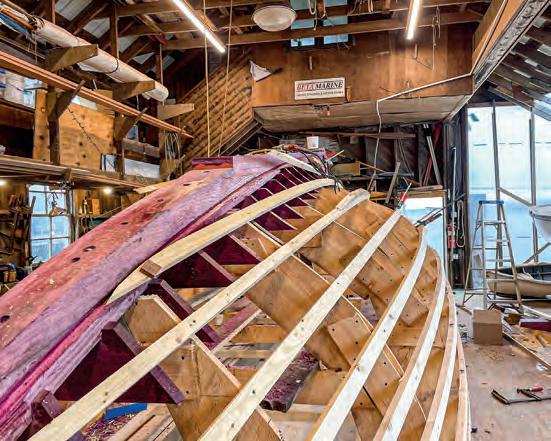
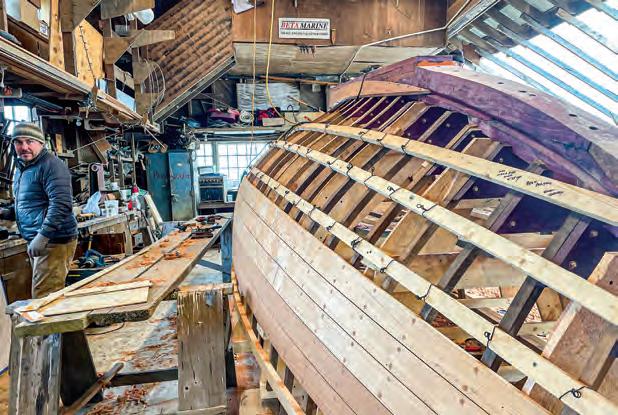
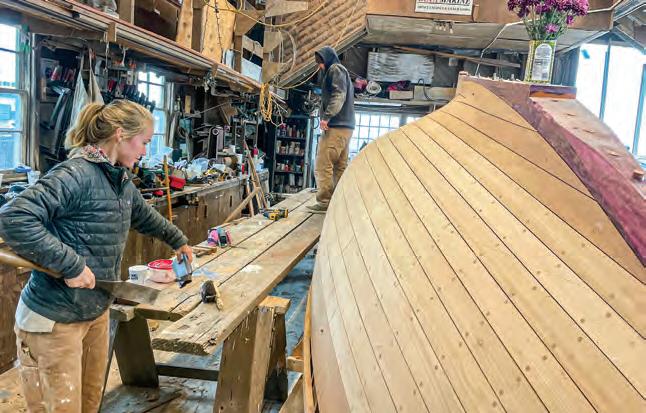



FEATURE • SOLAR-POWERED BOAT 53 marthasvineyard. .com Caption.
PHOTOS BY HARRY RICCIARDI
neer’s training to use and hauled it out at the head of the harbor, at the end of Beach Road Extension.
Over the course of a couple of fall days in 1978, Ross and Nat replaced all of Urchin’s frames. The magazine WoodenBoat was new, and it had caught the attention of people like Ross and Nat, capable people who had grown up around wooden boats, appreciated them deliriously, but were struggling to keep them afloat. They were hungry for information that you still can’t find on Youtube. Wooden boats were already relatively rare, and Vineyard Haven, which had become a spontaneous gathering place for wooden boat owners and enthusiasts, was home to a number of old boats that needed repairs similar to those Ross and Nat had made to Urchin.
With deep water and easy access to some of the world’s most extraordinary sailboat cruising grounds, Vineyard Haven has always appealed to serious mariners. Its culture and reputation has always been that of a working harbor, providing a foothold on the Island for necessary infrastructure. People who worked as yacht captains and merchant mariners, or locally in marine trades, hauling building materials, driving pilings, and building boats, usually kept their boats there.
This past winter, Nat and Ross began work (on spec) on Nat’s 100th design, a twenty-seven foot sloop that will carry a gaff rig and hide an inboard electric motor. They built their shop and railway after they repaired Urchin, with the aim of servicing the needs of the vibrant community around them. “Maybe building a boat here and there. We never expected any of this,” Ross says, nodding at the bustle of activity and the boats crowded into the yard.

More than seventy original boats they’ve built to Nat’s designs. The new boat is the product of a forty-four-year commitment to a place and a craft, a community’s commitment of sweat and resources.
Managed now by their partner in the business, Brad Abbot, Gannon and Benjamin Marine Railway services and maintains dozens of boats, still builds
a new boat every couple years, and constantly has a few boats in the yard having repair work done. When Design Number 100, which everybody around the shop has been calling Marta in appreciation of the company’s talented bookkeeper, was drawn on the shop floor in January, there were two local boats on the railway, one in for maintenance and the other for modifications, a boat on jack stands in the driveway for repairs, and at least four boats in the shed across the street, undergoing various stages of major restorations.
“I enjoy being involved here, because we’re all sailors,” said Brad Abbot this spring. “When we build or rebuild, it’s fulfilling for me because we have that angle. You look at something with people you trust, and you say, ‘What’s the best way to do this?’ You know you’re putting something on the water that’s going to work well and, especially with Nat’s boats, behave the way you want.”
As both solar panel and battery technology have improved, more boat owners are using electric motors to provide auxiliary power on sail boats. Marta will be the first local boat to put the motor down below and connect it to a propeller shaft, the same way you would use an inboard diesel motor. “The battery technology is such that somebody can rely on it,” Brad says.
A pair of small solar panels that will lie on the cockpit seats while she is on her mooring, will provide sufficient energy to power Marta in and out of the harbor between races and adventures. The batteries will likely store enough power for a return trip from Tarpaulin Cove or Cuttyhunk on a breathless summer day.
Most of the work on Marta has been done by Ross’s oldest son, Lyle Zell, and Andrew Chapman, a trained boat builder who has years of experience in construction boatyards in Maine, Newport, and beyond. For five years, the two have worked side-by-side in Vineyard Haven, learning from each other and adapting their techniques.
“Most of the boatbuilding I know I learned from my Dad,” says Lyle (who also has a degree focused on systems
54 MARTHA’S VINEYARD /EARLY SUMMER 2023 SOLAR-POWERED BOAT • FEATURE
With deep water and easy access to some of the world’s most extraordinary sailboat cruising grounds, Vineyard Haven has always appealed to serious mariners.
PHOTO BY SHENY LEON
A pair of small solar panels will lie on the cockpit seats while she is on her mooring, and will provide sufficient energy to power Marta in and out of the harbor between races and adventures.

FEATURE • SOLAR-POWERED BOAT 55 marthasvineyard. .com
always surprises us,” he adds, referring to himself and his wife, Kirsten, Olin’s and Greta’s mother. “They seem to know how to do things you wouldn’t expect. How to drive a machine or position your body when you pull on a line, all these things like they’ve done them before, just from being around it.”
“In the early years,” Nat says, “Ross and I did everything on our own. Some of the paint jobs were not the best. But we always wanted to see this expand into more of a community, rather than a couple wooden boat hippies living their dream.”

The shop is still a place where a retired
local teacher can haul out their cranky old wooden boat and do the yearly maintenance on it themselves. “I feel like human beings need to create,’ says Nat, “that all of them want to create something. I feel those that don’t get the opportunity are usually kind of frustrated.”

“At the end of the day, it’s about spending time on the water,” Andy Chapman says regarding his approach to his particular craft. “You try and make that experience beautiful. Nat’s boats do that as well as any boats in the world.” Andy’s own boat is one of Nat’s designs. He bought Maybe Baby when it needed some help after thirty years of regular use.
In the summer he sails it almost every day, but during the rest of the year he has been restoring it, season by season, on nights and weekends in his backyard in Vineyard Haven. He keeps it almost exactly as it was when it was launched, though he painted its hull moss green.

When the mainsail goes up, mast hoops clack against the fir spar. Maybe Baby glides easily and swivels through tacks in a light breeze. Under a torrent of wind, reefed down, she feels safe and comfortable as she bucks against a chop. She has a manageable enough rig to always feel safe, but is powerful enough to compete well in local races.
Nat thinks he’s gotten better at drawing boats over the years. “I used to make a half model to see it in three dimensions,” he says, “now I just do it on paper.”
Because they are both gaff sloops, of similar size and Nat’s design, many times during Marta’s construction, friends coming through the shop have pointed out the differences between her and Maybe Baby. Andy always says, “I’m curious how she’ll sail against the Baby.”
56 MARTHA’S VINEYARD /EARLY SUMMER 2023 SOLAR-POWERED BOAT • FEATURE
Marta's recent launch into Vineyard Haven Harbor.
Left, Kirsten Scott and Ross Gannon, and Nat and Pam Benjamin, June 2023, after more than forty years of building and repairing wooden boats in Vineyard Haven.
PHOTOS BY KATIE CHAPMAN
transitions from the four-sided tail, growing to six planes and then to eight, making it appear as though the structure is alive, expanding and contracting in all directions. Every piece has a complex angle. “Covid was great for this project. It was so quiet. I could completely drop in
and focus,” Tony says. I also suspect some of Tony’s training as an ultramarathoner, which he is very quiet about, contributes to his ability to stay in the present and realize such detailed work.

By the time my family arrived to look at his puppies, Tony was almost done.
He had nearly all the panels in place and was ready to braze each section together. By the next time I visited again, it was the day before the seahorse was headed to Aquinnah to be installed. “I have to admit.” Tony said with a chuckle, “I’m having a little separation anxiety.”




Fortunately, he can go and visit. A few weeks after it was installed, Tony and Dawn went for breakfast at the Outermost and stopped by to see the seahorse on their way home. In late spring, I finally had a chance to go see it . I gasped out a “Wow!” when I saw it. After its first winter outside, the copper had a beautiful patina — deep browns, hot oranges, and a few flashes of verdigris. Tony’s work had brought the organic lines of nature and the more structured lines of the house together. “To think this was supposed to be a thirty-two-inch whale,” Tony quips.
Driving home, I reflected on watching Tony’s process from the sidelines. Tony is right: He does live in rarified air, because he is able to stop, look, and think about things (like the essence of a seahorse and Martha’s Vineyard), and then produce something that helps other people reflect and see things differently. Tony’s seahorse is placed in such a way that it serves as a kind of welcome guide as you walk toward the house. It is so spectacular that you have to stop and look. And then you see the trees, the plants, and the sea beyond. And this pause that he created, even if it is just for a few seconds, gives one an opportunity to appreciate the earth and the good fortune of being one of the people who roams it — and maybe even swims amongst the seahorses.
HANDMADE • A SEAHORSE 57 marthasvineyard. .com
Continued from page 14
The finished seahorse is seven feet high and eleven feet long when it is finally lifted into place at the "Whale House."
Continued from page 25
But these efforts do buy time. Zoos’ modern focus on genetic diversity and minimum viable populations, with decisions made using cooperative Species Survival Plans, has made headway for California Condors, Black-footed ferrets, and Arabian Oryx, among other animals (although the ultimate recovery of these species still depends on addressing the underlying causes of their decline). Zookeeping has also led to important developments in wildlife veterinary medicine, which can improve conservation efforts for populations in the wild and provide insights into the detailed minutiae of animal biology that researchers would have a hard time accessing in the field.
Zoos, many conservationists argue, are a form of triage in the face of cascading ecological catastrophe in the outside world. Aligned more than ever with the field of conservation biology, itself a relative newcomer in science, zoos are also devoting money to protecting species in situ, and to ensuring the ongoing viability and diversity of the broader wild landscapes in which those species dwell.
At the same time, protected areas like national parks increasingly behave more like zoos, with biologists closely
tracking and supervising animals, providing medical care, and drawing strict boundaries that restrict freedom of movement and natural migration.
“They’re going to be managed in the same kinds of ways zoos are,” Rothfels said. “Identifying who is breeding with which, and taking out individuals that need to be translocated. And so the
world ends up looking much more like a bigger zoo.”
In any case, Rothfels pointed out, the fraction of zoos’ actual day-to-day activity and budget devoted to substantial conservation work is small, often out of proportion to their claims; much of the most significant work in the field is done by a few large institutions, like the Bronx Zoo (and its parent organization, the Wildlife Society) or the Monterey Bay Aquarium. The remaining resources are devoted to zoos’ historical purpose: drawing a crowd.


One zoo employee, quoted by sociologist David Grazian in his book American Zoo: A Sociological Safari, bemoaned the extent to which her institution had become like Chuck E. Cheese, with claw-machine games in the cafeteria and a bouncy house almost every weekend. “We have the moon bounce all the time,” she told Grazian. “‘The moon bounce is here! The moon bounce is there!’ What the heck?”
And that’s not to mention the effects of captivity on the animals themselves. As research pours in about the sophistication and mystery of animal minds, it becomes increasingly fraught to keep and exhibit them, no matter how much we strive to disguise the nature of their captivity.
“Zoos cannot but disappoint,” wrote the critic John Berger, whose essay “Why Look at Animals” is inevitably encountered by people researching this topic. “The zoo to which people go to meet animals, to observe them, to see them, is, in fact, a monument to the impossibility of such encounters.”
Some zoos are accredited — an industry standard, but a standard nonetheless. “There are some things in that accreditation that really count,” Rothfels said. “Do you have onsite veterinary care? Do you have people with actual expertise here who know things? Or is it just somebody you hired to throw meat to the lions? Is there an actual education program?
WHAT'S SO BAD ABOUT ZOOS • FEATURE 58 MARTHA’S VINEYARD /EARLY SUMMER 2023
Is there a good perimeter fence? Do you have financials which make it clear that your institution will be able to survive through difficult times and not just turn your animals loose?”
And “turning loose” zoo animals is no easy task. Many zoo animals are emotionally troubled as a result of their lives in captivity. Others have become overly acclimatized to people, losing their fear of human beings and, in some cases, developing strong emotional bonds with their zookeepers. Circumstances such as these make a truly ‘wild’ life for them, whatever we take that to be, forever out of reach.
Rothfels takes the long view. Zoos are likely to stick around for the foreseeable future, he thinks. But “pushback has made zoos better,” he told me. “Animals live longer. The quality of their life is better. There's more attention to their mental needs.”
“If it were me, I would have many fewer

facilities, much more regulation,” he said. “Fewer places that were much better. But that's not the way this country runs, right? State by state, the regulations are so different.”

In some ways, zoos are better for studying Homo sapiens than wild animals: they reflect and refract our desires for connection with nature, with animal intelligence, and with pre-history. How zoos move forward depends in part on these desires. Do we prefer a deeper illusion, to immerse ourselves ever more convincingly in a facsimile of animal life in the wild? An old-fashioned, profit-seeking enterprise of spectacle and comic relief? Or something else, something new?
“The single thing that I want of zoos is that they ask themselves tough questions about why it is they're doing what they're doing,” Rothfels told me.


FEATURE • WHAT'S SO BAD ABOUT ZOOS 59 marthasvineyard. .com
Sign up for the Your Daily Dot newsletter! Sign up for our newsletters here: bit.ly/BDL-newsletters Each weekday morning, we’ll send you a Climate Quick Tip — easy advice for Earth-friendly living — and on Saturdays, Dot will answer one of your questions. On Sundays, Dot rests.

















BDL 60 MARTHA’S VINEYARD /EARLY SUMMER 2023 Subscribe at: marthasvineyard.bluedotliving.com/magazine-subscriptions Or, email us at subscriptions@bluedotliving.com 4 ISSUES Plus OUR GREEN GUIDE TO MV for the introductory rate of $24.95 Mailed directly to you, or as a gift from you. Subscribe now, and we’ll send you a downloadable collection of Bluedot Kitchen Recipes. Bluedot Green Guide MARTHA’S VINEYARD SIMPLE / SMART / SUSTAINABLE / BUSINESSES ARTISANS · BANKERS · BUILDERS · COOKS · DESIGNERS FARMERS GARDENERS · NON-PROFITS · SHOPKEEPERS MARTHA'S VINEYARD REAL ESTATE WITH DEEP ROOTS IN THE COMMUNITY South Mountain shows that Carbon-Neutral building is possible YOUR GUIDE TO ECO-FRIENDLY MV
“We are surrounded by geniuses,” says Janine Benyus, co-founder of The Biomimicry Institute. She isn’t referring to the billionaires in our midst, set on shooting us all to the stars, but rather the natural world around us, geniuses all, who work within a beautifully balanced system.

Biomimicry, according to Benyus, is the practice of noticing how nature solves problems and then applying that design to innovations all around us. We already see biomimicry in products









all around us. Your down-filled coat (have you ever seen a cold goose?), the Velcro fastener (look no further than the burrs attached to your hiking pants). The shape of wind turbines are modeled after the ridges of a whale’s pectoral fins, which create an aerodynamic flow. Shatterproof glass took its inspiration from spider webs.
In her seminal book, Biomimicry: Innovation Inspired by Nature, Benyus summarizes fundamental observations of the natural world:
Nature runs on sunlight.
Nature uses only the energy it needs.
Nature fits form to function.
Nature recycles everything.
Nature rewards cooperation.
Nature banks on diversity.
Nature demands local expertise.
Nature curbs excesses from within.
Nature taps the power of limits.
Benyus has never forgotten the lessons she learned as a young child exploring the wild spaces near her home. She was awed then and she remains so. Biomimicry. It’s as simple as paying attention to those geniuses around us, and taking instruction from them.
IN A WORD 61 marthasvineyard. .com
Buy less, but when you do — buy better. Shop the BuyBetter Marketplace Sign up for Bluedot Living’s BuyBetter Marketplace, a biweekly newsletter that navigates the confusing world of stuff. bluedotliving.com/marketplace In a world of disposable goods, it’s hard to know which products are sustainable. At Bluedot, we do the legwork for you by selecting items made with regard for the planet and its people. Sign up for the BuyBetter Newsletter here: bit.ly/BDL-newsletters
Biomimicry in a word
'
the imitation of natural biological designs or processes in engineering or invention:
biomimetics. bio·mim·ic·ry ¦bī-( )ō-¦mi-mi-krē

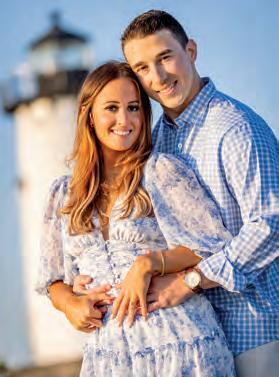
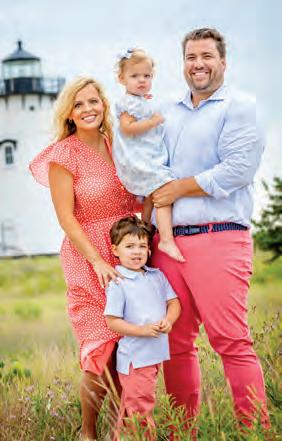
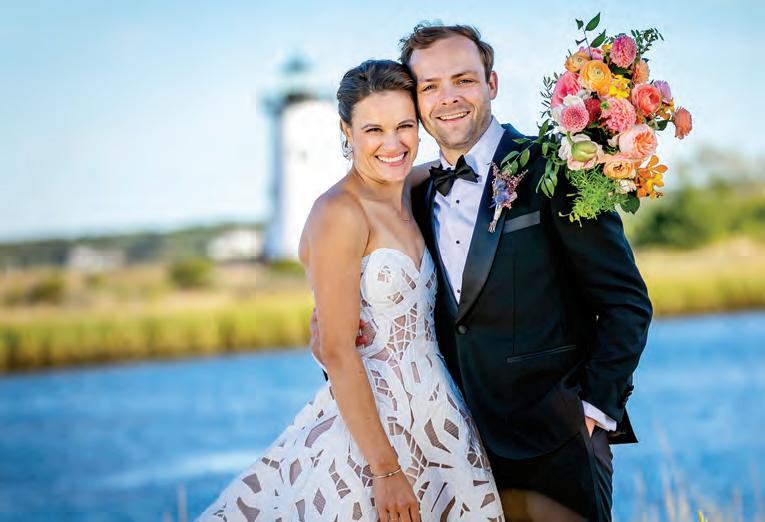



BDL 62 MARTHA’S VINEYARD /EARLY SUMMER 2023 www.randibaird.com 508-505-5909 Family Portraits EngagEmEnts · WEddings
Continued from page 64
highway there would have opened up the moors at Lobsterville and out to West Basin to intensive development. The way the organization managed that fight was a compromise, and that was a lesson for future years. The road was built because we realized the importance of access to West Basin by local fishermen and others, but it was declassified, and no longer a state highway. Instead, the road was classified as a limited access highway, which means no curb cuts opening that interior land to development. That was one of VCS’ very early wins. Then, within a year, VCS worked with many people involved in the West Basin matter, sometimes from the other side of the fence, to designate the Gay Head Cliffs a national natural landmark in 1966.
BDL: What was it like taking the leadership role at VCS?
BO: I took over at VCS at a time in the mid ‘80s when the emphasis was on farmland protection. Into the ‘90s, the focus shifted to defending open space and land use litigation. There were a number of high-profile matters that VCS was involved in where we wore our advocacy hat. We’re the Island’s local environmental group, and so we are tasked by the community to be that voice for the land and the waters and all habitats of Martha’s Vineyard. On into the 2000s and 2010s and up to today, our multidisciplinary mission shifts depending on the need. In recent years it’s been about education, sustainability issues, ecosystem health, and water quality. Having that unique mission attribute where we can focus on advocacy, land protection, education, and outreach, depending on the need, has made VCS quite versatile over the years and a real community asset.
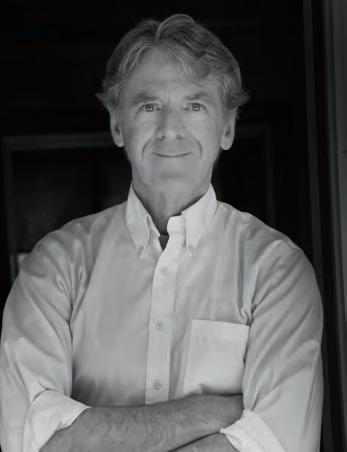
BDL: What are some accomplishments VCS achieved during your tenure?

BO: A lot of the indicators of achievement are rightly about land protection.
We have a number of accomplishments in that category that we can point to — broadly speaking, the protection of the watersheds such as those of Mill Brook and Tiasquam River, along with properties like the Woods Preserve, Polly Hill Arboretum, and Waskosim’s Rock Reservation. There are also a number of private conservation restrictions on land like Brookside Farm, as well as the flagship project that we are in our twenty-seventh year working on — the rare habitat areas along Moshup Trail in Aquinnah.
BDL: How about some successes not related to land use?
BO: While open space protection is critical, one of the things that has changed over the years is that we now have a Land Bank Commission. We have other very capable land trusts doing this important work. Having the identity at VCS as a broad environmental group has allowed us to take on this full sustainability agenda that the public may be more familiar with: the plastics reduction campaign, water bottle refill stations that reduce single use plastics, energy conservation, and the community events that we all love like the Earth Day Beach Cleanup and the High School Environmental Art Contest. All these efforts are aimed at one theme, and that’s to coordinate with our colleagues to try and create better environmental outcomes for the Vineyard.
BDL: How did your experience in environmental law help once you took over?
BO: Early on, VCS began moving in the direction of environmental legal defense, and that does happen to dovetail well with my own training. We saw some of the real milestone legal disputes on the Vineyard occur during that time. These were controversies like the Nobnocket bank and supermarket development in Vineyard Haven, and the many years of private golf course development land use disputes — at least five separate golf course proposals. We fought those in the local and regional regulatory venues, and
it took a lot of commitment. The result is that we steered development in a slightly different direction. Instead of having five private golf clubs, we have the Vineyard Golf Club, which is managed organically in Edgartown on a property that was a defunct subdivision with quite a bit of development capacity.
BDL: How does it feel to be retiring and passing the torch to Sam after so long?
BO: I’m really excited about the good work continuing and welcoming the new executive director, Sam Look. We will see the next generation of environmentalists being given an opportunity to shine. I have high confidence that VCS is in good hands, and that the community can expect great things. All of our staff members at VCS have served for ten or more years. Sam comes from the unique perspective of starting with VCS as a board member, so she has experience from both the staff and the boardroom side. She is a local person from West Tisbury, she grew up here, went to school here, and knows the ropes better than most. In my retirement I will be throttling back some but will still be involved in the community. I’m looking forward to having some more time for my wish list, and I’ll certainly be enjoying some of these wonderful places protected by all our colleague groups over the years.
BRENDAN O'NEILL • LOCAL HERO 63 marthasvineyard. .com
PHOTO BY MYA O'NEILL
Brendan O'Neill
LOCAL HEROES
Brendan O’Neill
Leading Vineyard Conservation Society for almost four decades.
The next time you stand by the railing wrapping the overlook of the pastel Gay Head Cliffs, try and consider all it took to preserve that stunning natural landmark. The next time you stroll along Mill Brook through the ecologically diverse landscape, stop for a moment to think about the village it took to protect our Island woodlands from unfettered development.
Among several conservation organizations that maintain the natural wonders of our Island, Vineyard Conservation Society has been a stalwart advocate in all realms of environmental protection. Brendan O’Neill has been at the helm of VCS for nearly 40 years and is now passing the torch to the next local leader, Samantha Look.
Over the decades, O’Neill has been an instrumental defender of natural spaces on-Island. O’Neill, whofirst visited the Vineyard with his family in 1971 and was struck by the rural character and unique landscapes here, has been involved in many high-profile land protection and designation matters during his time at VCS. His passion for preservation has guided the organization in helping create
many of the open and wild spaces we enjoy today.
Bluedot Living: How did VCS begin? Who founded it?
Brendan O’Neill: Vineyard Conservation Society was founded in 1965 by a core of year-round and seasonal people who saw a need for a new kind of organization that would be local, with a board made up of local and seasonal people. Their charge was to work on environmentalism, broadly speaking. There was a strong need for a group on the Island that was not strictly in the business of land trusts — an organization to fight for all our natural spaces in different ways.
BDL: Where did you grow up and how did you find Martha’s Vineyard?
BO: My family first visited the Island during the summer of 1971. Growing up in Yonkers, New York, and going to secondary school in the Bronx, I was always interested in protected lands near where I lived, and I gravitated toward those. Mar-
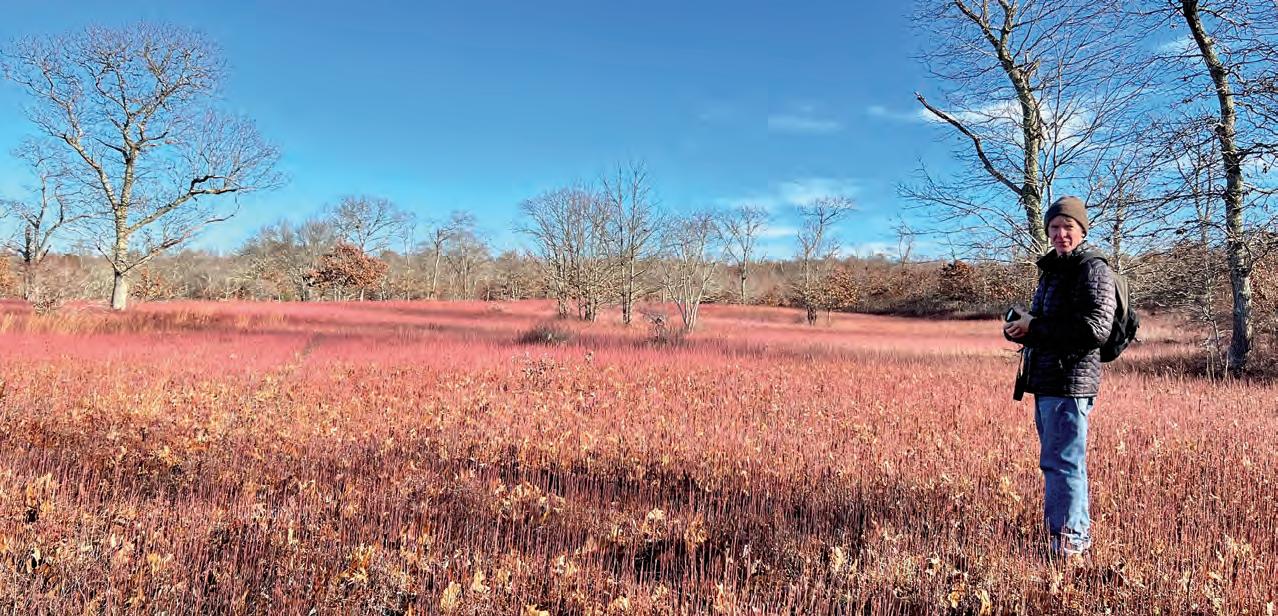
tha’s Vineyard was just such a different landscape; seeing the Island was a huge eye opener — I saw what was possible in a place where people really care about the environment. There were a couple different connections I had to the Island. Dana Gaines was my roommate in college, but I really credit my friend Thom Mayhew with alerting me to the job opportunity at VCS. During law school I worked on the Vineyard [in the summertime] driving cab for Hathaway’s and John’s Taxi, and I got a sense of the place and its physical and political landscape.
BDL: What was one early battle that VCS was involved in after its inception?
BO: Before my time, VCS was organized with an eye toward a particular land use controversy at the time — the development of West Basin Road in Aquinnah. This was a proposal to create a state highway so people could access the harbor there. VCS was opposed to that, because, at the time, there was very little in terms of local zoning in Island towns. A state
Continued on page 63
LOCAL HERO 64 MARTHA’S VINEYARD /EARLY SUMMER 2023
Interview by Lucas Thors
Brendan O'Neill at Woods Preserve
PHOTO BY SIGNE BENJAMIN



CLAM POINT COVE WATERFRONT, CHILMARK

This 3 acre compound is an exceptional waterfront property with breathtaking unobstructed pond views from an elevated secure location, 250+ ft of pond frontage, 48 ft dock with separate mooring for easy access to Menemsha Pond and Vineyard Sound. The main house is a spacious 5-bedroom with 5 baths with a well sited 2-bedroom 1 bath guest house. Come launch your canoe, kayak or paddle board from spring to fall; swim, clam, or sail off the point all summer long; sunbathe on your private dock or 3 decks or on the terraced lawn overhanging the cove; and enjoy seasonal holidays by a roaring fire with extended family and loved ones. Exclusively offered at $9,950,000.




An
Specializing
Choice
50 Years 504 State Road, West Tisbury MA 02575 Beetlebung Corner, Chilmark MA 02535 www.tealaneassociates.com 508.645.2628 Chilmark
Independent Firm
in
Properties for
508.696.9999 West Tisbury











 By Julia Cooper
By Julia Cooper


















































 – Jennifer
– Jennifer



 Story By Mollie Doyle Photos by Randi Baird
Story By Mollie Doyle Photos by Randi Baird


















 DeVivo packs up food for the trip to Edgartown.
DeVivo packs up food for the trip to Edgartown.













 Story by Laura D. Roosevelt
Story by Laura D. Roosevelt





































































